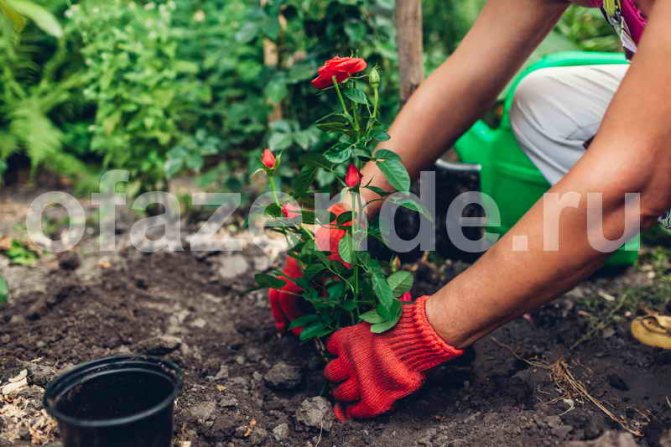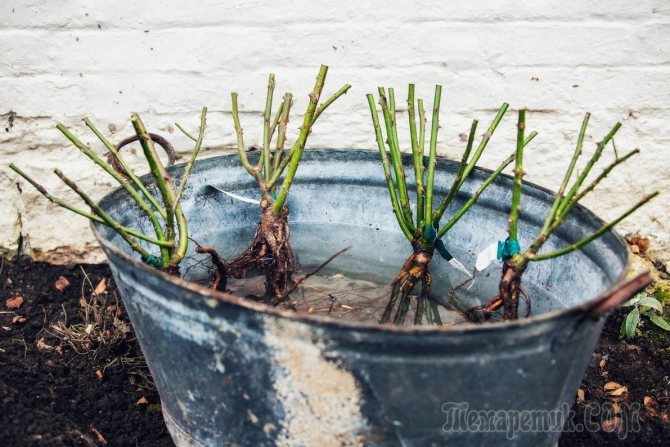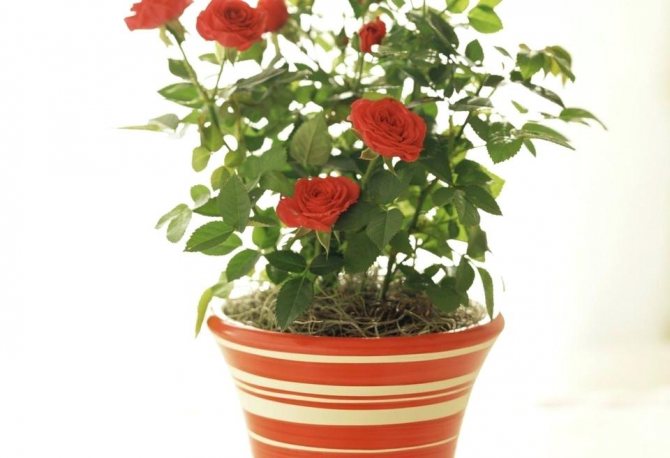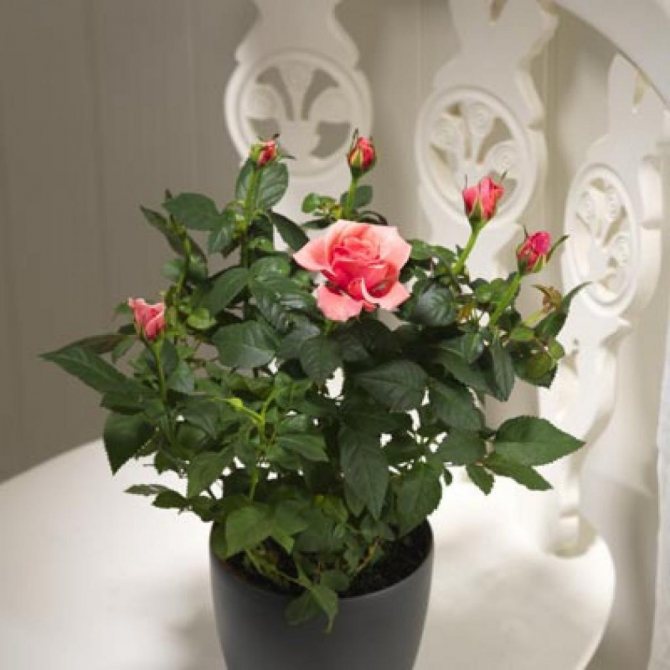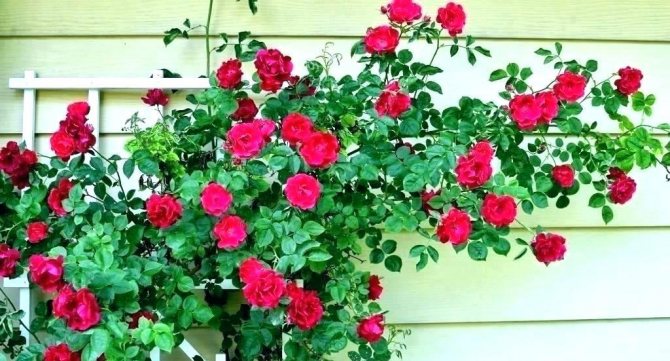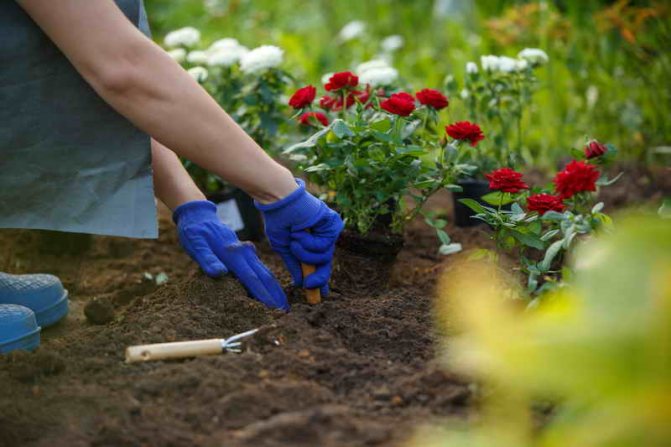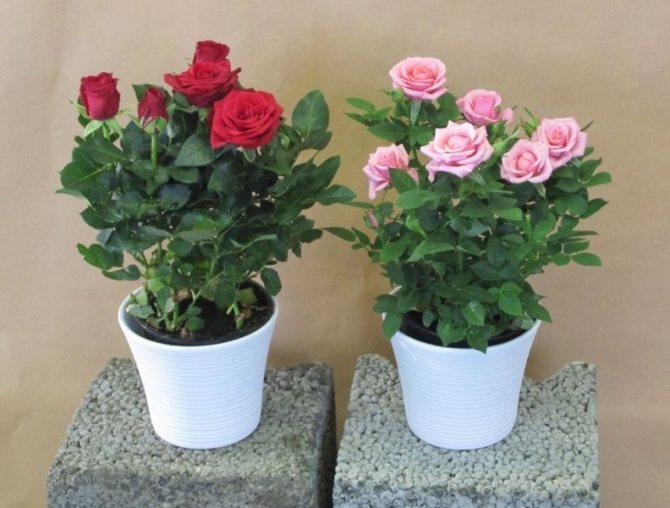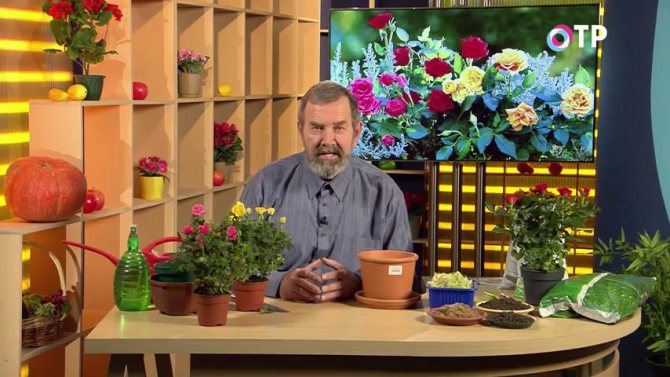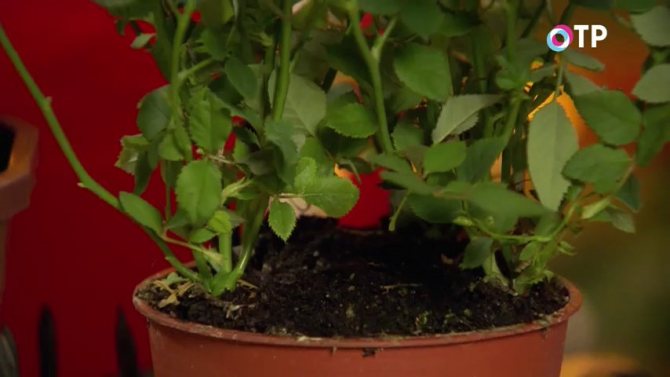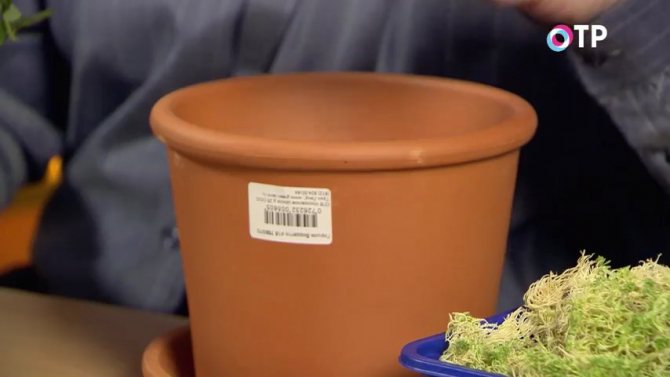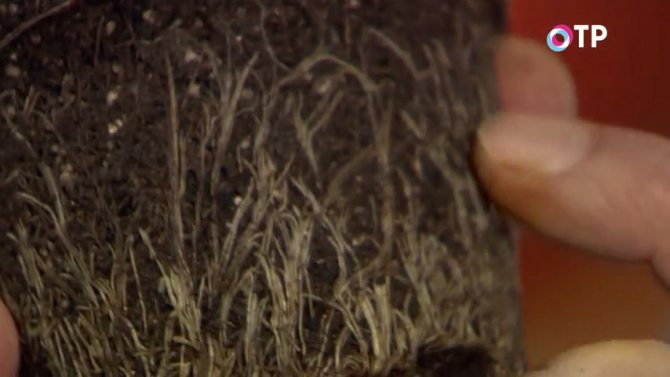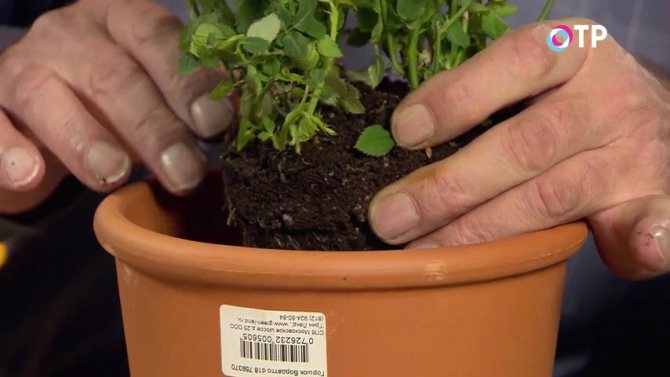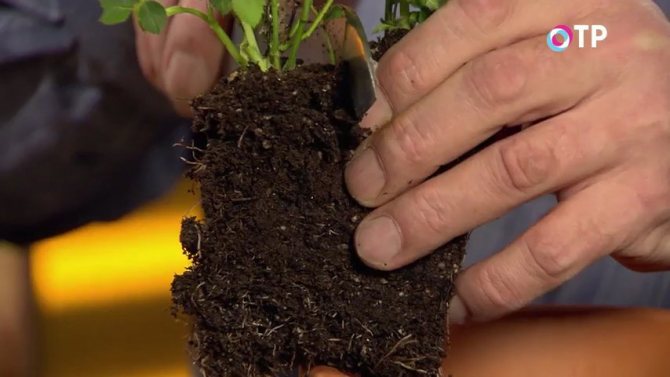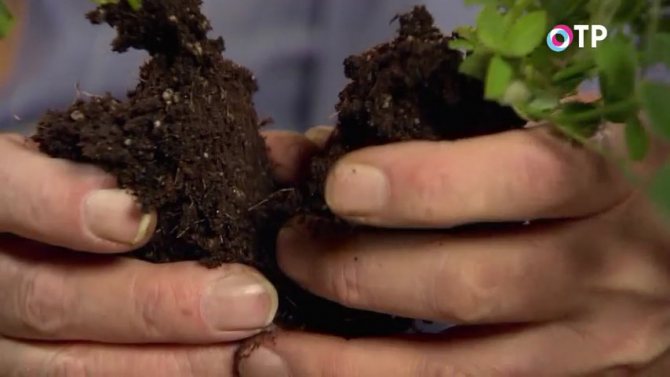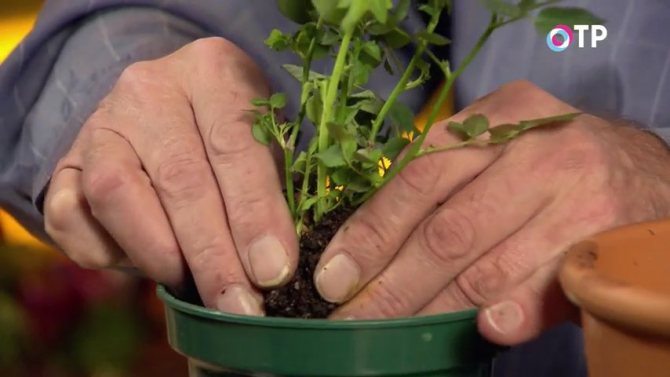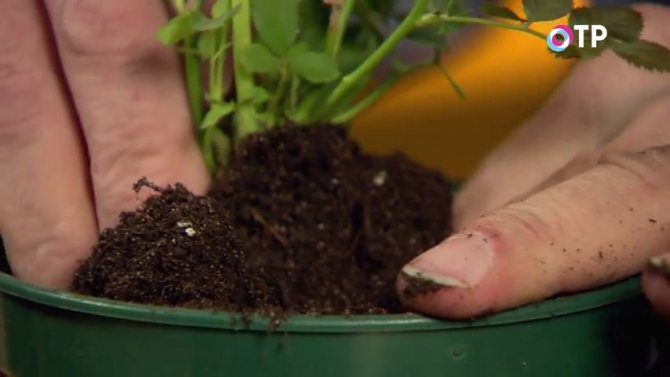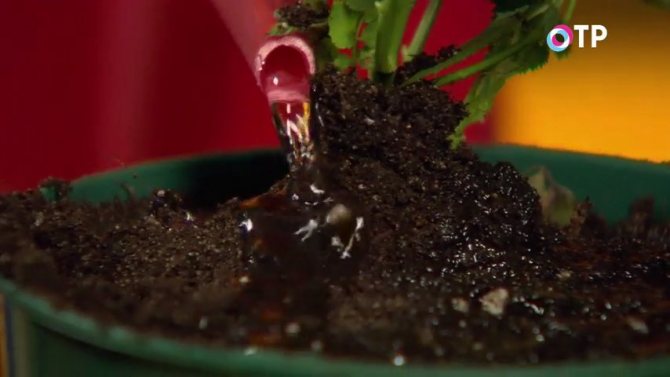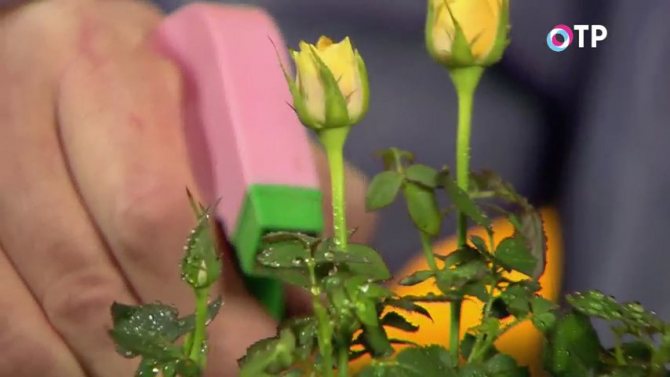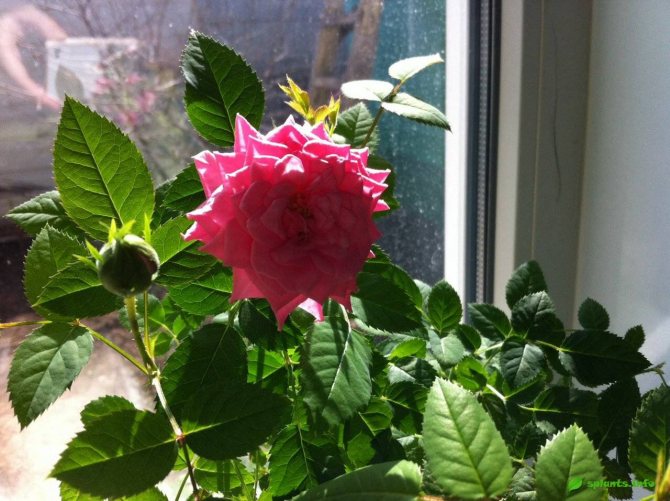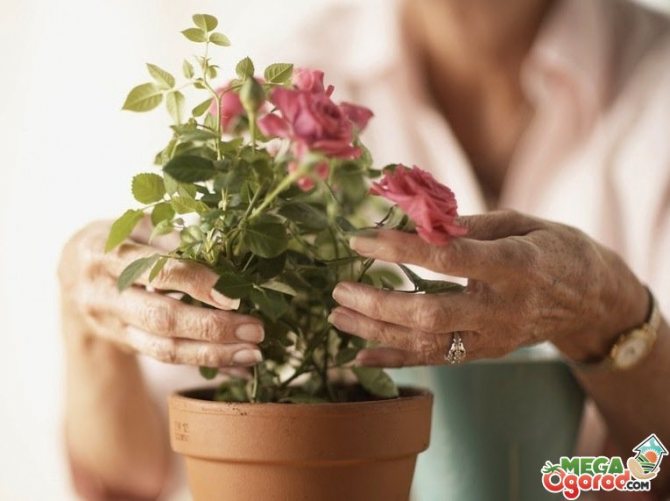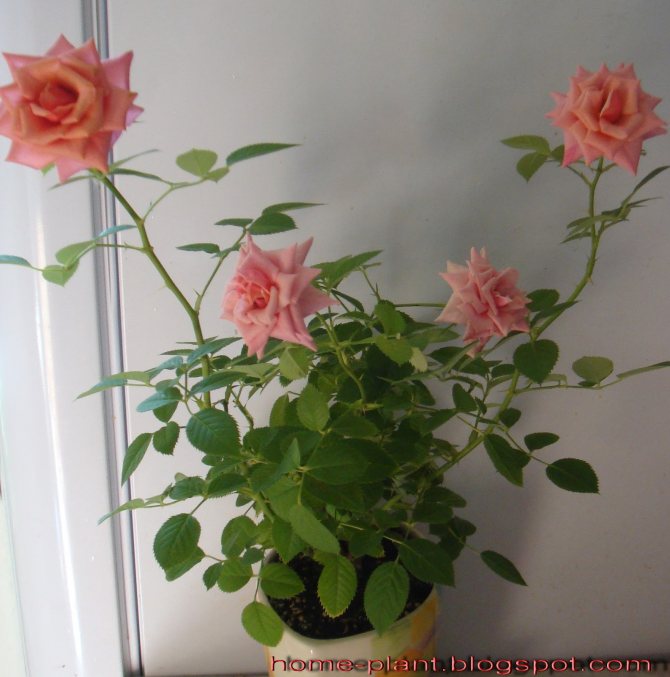- October 31, 2018
- Houseplants
- Efimova Anastasia
Rose is the queen of flowers. Every novice amateur florist dreams of having such a plant. And many gardeners prefer to grow exclusively roses - garden and home.
Indoor flowers differ from their counterparts in compact size and small buds. And it seems to some that it is much easier to care for them than for garden ones. In fact, the indoor rose is a rather capricious plant. And after some time after buying a flowering bush, you may find that only memories are left of it.
How to properly transplant a room rose after purchase so that it does not die? After all, it depends on the transplant and good care whether the plant will be healthy. Let's try to understand this topic.
How to understand that a transplant is needed
Knowing when to transplant a bush rose in a pot should be for several reasons. First, plants should not grow in the same potting mix that is prepared for distillation in stores. It is processed with special solutions and fertilizers, allowing a lush bush with many buds to grow in a short period of time. After stopping top dressing at home, the bush will immediately begin to lose its decorative appearance.
Secondly, plastic containers are usually selected in the smallest size, and the root system in them quickly becomes cramped. The need for transplantation in this case is evidenced by the rapid drying out of the soil, wilting and yellowing of the leaves, stem and buds. That is why, after purchase, a room rose is transplanted into another container, completely replacing the soil. The procedure is also necessary if the plant is sick, begins to dry out, does not bloom for a long time, provided that the required conditions are met.
On a note. The bush brought from the store is transplanted 1.5-2 weeks after purchase, giving the home rose time to adapt to the new microclimate in the apartment. Before this, the stems and leaves are examined for the presence / absence of pests, the faded buds are cut off.
Features of transplanting a climbing (curly) rose
It is best to transplant the climbing rose in the fall, but not late, from mid-October or spring, before budding begins. The landing site needs to be chosen well-lit and spacious.
Basic transplant tips:
- first you need to remove the rose from the support and trim the shoots, leaving the shoots up to 30 cm;
- cut points can be treated with activated carbon and covered with garden pitch;
- prepare a landing pit with a depth of at least 60 cm;
- immerse the bush in a hole; make sure that the roots do not bend up;
- deepen the root collar into the ground by about 5 cm;
- cover the roots with prepared soil, water the plant.
Difficulty can also arise when transplanting a ground cover rose. These roses can be cut to get to the roots, and the branches can be gathered together and bandaged so that they do not get in the way and do not prick.
Post-purchase actions
A purchased rose in a pot immediately after delivery from the store is subjected to a number of simple manipulations:
- remove paper packaging or cellophane from the flower, remove labels, bows from the pot;
- inspect the bush for the absence of pests, since in the store there is a risk of infection with aphids, spider mites;
- cut off dried leaves, branches, remove all the buds with a pruner to save the strength of a miniature bush;
- wash the plant with warm soapy water, lowering it in a basin for a few minutes or holding it under the shower;
- add 5 drops of "Epin", "Fitosporin", "Fitoverma" to 1 liter of water to choose from, spray the stems, leaves and the top layer of soil with this solution to prevent the appearance of diseases, pests, strengthen the immune system of the flower;
- they build a "greenhouse" from a cellophane bag stretched over bamboo sticks stuck into the ground;
- air the "greenhouse" daily, increasing the intervals, then remove the shelter;
- stop after 10-14 days "quarantine", prepare the ground, container and soil for transplanting roses from the store into a more spacious pot.
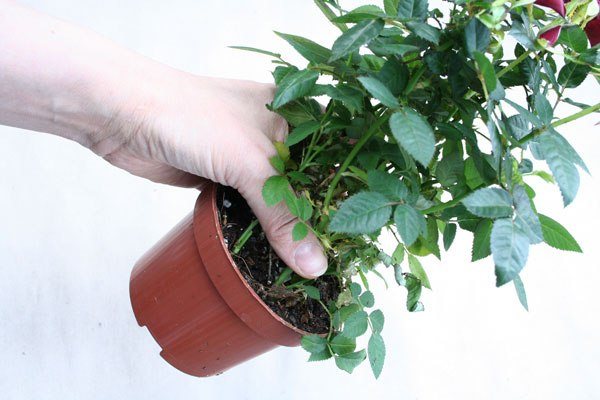
Roses in flowerpots. HOW TO GROW ROSES IN POTS


Did you know that anything that grows in the ground can be grown in containers. This is true even for potted roses. The only thing that is always important to remember is that they need to be watered and fertilized more often. These plants can be used to decorate a balcony, entrance, patio or terrace. They are versatile because they can move anywhere you want and grow in any size garden.
What steps should be taken for roses to grow well in pots
- Planting a rose in a pot. Fill the pot ⅔ full with planting mixture. Spread the roots over the top. Fill in the roots and fill the container to the end. Water well.
- Caring for potted roses. It is necessary to water the container rose when the soil mixture dries up 2-3 cm deep. Fertilize such plants once every 2 weeks with water-soluble fertilizers.
- The distance between the pots with roses is at least 60 cm. This is necessary for good air circulation between them and will reduce the risk of fungal diseases.
- Potted roses, like ground roses, need 6-7 hours of direct sunlight.
- The time and type of pruning for roses in tubs is the same as for flower beds.
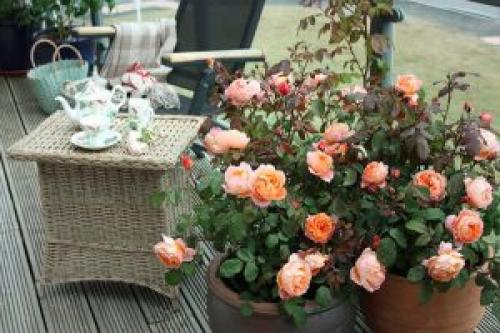

Pot. You can use plastic or ceramic. In cooler regions, plastic lives longer, cracks less in the cold, in contrast to ceramics. In warm areas, ceramic pots will keep the root system from overheating and drying out. The size of the container depends on the rose grown in it. The larger the flower, the larger the pot. For miniature roses, the height of the vessel should be at least 25 cm, if the height of the rose is 45 cm. For roses up to 60 cm in height, a pot with a height of 30 cm is suitable. For shrub roses up to 60 cm in height, buy vases with a height of 40 cm. For roses with a height of 1.2 m fit high urns (from 50 cm in height). The diameter of the pot will depend on the root system. Please note that it must fit there freely.


Substrate. Roses love healthy, rich soil. They consume a lot of nutrients in order to grow and flower. For roses in pots, either a ready-made substrate is selected, or they themselves prepare it from the ground, garden compost and rotted manure. Perlite can be added to this mixture as drainage. The correct soil in a pot is more than half the success.


In cold climates, you will need to hide potted roses in a cool room.
Almost all roses grow well in pots. Difficulties will only be caused by large and climbing roses. They have a large root system and need more space around them.


Enjoy your cultivation!
When is the best time to replant
Transplanting a room rose after purchase is usually carried out in the spring or early to mid-August, but you can carry out the procedure at any other time. If a flower in a pot was presented on March 8, New Year or an anniversary in September, you should not postpone an important event until the spring months. It is enough to complete the above steps in order to properly prepare the root system and the bush itself for transplanting into a new flowerpot.
Many novice flower growers are interested in how often it is necessary to transplant a plant when kept indoors. It all depends on the size of the pot and the bush itself, the type of rose. It is enough to transplant miniature varieties immediately after purchase, then the procedure should be carried out only once every 2-3 years. Larger bush varieties are recommended to be replanted annually in spring or every 2 years, dividing the rhizome if necessary for reproduction.
Transplant during flowering
There are several nuances of how to transplant a rose after buying it in a store, if it blooms or is completely covered with unopened buds. Here is a detailed flow chart.
- Remove the packaging from the donated or purchased flowering potted plant.
- Dip the bush in water with laundry soap dissolved in it for a few seconds.
- Cut off the dried leaves, cut off every single bud and open flowers with a pruner or a sharp knife.
- Treat the bush with any pest repellent.
- Cover with cellophane "greenhouse" for a week, remembering to regularly ventilate.
- Prepare soil, a pot in 10-12 days, transplant.
General rules for transplanting garden roses
- A place... The ideal place for planting roses in the country is an elevated, sunny area. It is not recommended to plant these flowers along the walls of the house, as the roots will grow over the years and begin to rest against the foundation.
- Pit... It is advisable to prepare a planting hole a week before planting a rose. Dig it out a little larger than the roots of the seedling. The size of the rose roots is equal to the area occupied by the crown. Pour water over an empty pit.
- Priming... Prepare organic soil. Add mullein and compost to purchased or garden soil.
- Preparing a rose seedling... Wrap the twine around the branches to the center so that they do not interfere with your work. Water the bush with water so that the soil does not move away from the roots during digging. Dig gently to the center root. Grafted roses have a very deep central root. Therefore, you will most likely have to partially chop it off. Use burlap to carry the bush to a new location.
- Transshipment... Trying not to destroy the earthen lump, transfer the plant into the hole. The grafting site on the bush should face south. Cover the free space with prepared earth, lightly press it down. Water the seedling with water with the addition of Kornevin. Free the twigs from the rope.
They begin to fertilize the transplanted rose after two weeks. In early spring, use fertilizers with a high nitrogen content for this, and in summer, switch to complex fertilizers for flowering plants.
What is required for a transplant
To transplant a rose after purchase, you need to do a little preparation. You will have to purchase in advance:
- pot - it should be more stable, roomy, preferably made of ceramics or plastic, plastic;
- priming - you can buy a special potting soil mixture for indoor roses or prepare it yourself;
- secateurs - it is needed to trim leaves, buds and blossoming flowers, if desired, the tool can be easily replaced with sharp scissors;
- container with warm water - in a basin or bucket, you will need to lower the roots to clear them of purchased land.
On a note. The new pot should be 4-6 cm taller and 3-4 cm wider than the one in which the plant was sold. If 3-4 roses are planted in a flowerpot for splendor, each bush at home is seated in separate flowerpots.
If it is not possible to find commercial soil for roses, a mixture for violets or other flowering plants (universal soil mixture) is suitable. To prepare the earth yourself, mix 4 parts of humus and turf with 1 part of river sand. The main condition is that the soil must be loose and moisture-permeable.
In a plastic pot, drainage holes must be made with a sharp knife or a nail heated on a fire. This is necessary so that the remaining water does not stagnate, causing root rot.Ceramic flowerpots without drainage holes in the bottom or side are not suitable for planting a capricious flower. Expanded clay of fine or medium fraction is used as drainage.
Frequently asked questions when transplanting roses
| Question | Answer |
| What if the transplanted rose withers? | Remember to keep the soil moist. The roots of a transplanted rose will find it easier to take root in moist soil. When watering the soil around the rose, add rooting stimulants (Kornevin, Kornerost). Consumption rate - 1 g per 1 liter of water. You can pour about 5 liters of water under the bush. Process the ground part of the plant Epin or Zircon... These are drugs - adaptogens with anti-stress action. Consumption rate - 1 ampoule per 10 liters of water. |
| When can you transplant rose cuttings? | A garden rose can be propagated by cuttings of the current and last year. A shoot 10-15 cm long is used as a cutting, from which all thorns are removed. The leaves are completely removed from the bottom, and only shortened from the top. Cuttings are prepared in the spring before flowering and in the fall when pruning the plant for the winter.... Cuttings planted in spring can be left for the winter in the open field. It is only recommended to cover them with agrofibre and foliage. Cuttings rooted in the fall are best kept in the basement until next spring. And in the garden, in the open ground, plant in April. |
| Can a flowering rose (with buds) be transplanted? | This can only be done with homemade miniature roses. Such a flower with buds can be transferred together with a lump of earth into a larger pot. You cannot do this with garden roses. You need to wait until the end of flowering, when 80% of the petals fall off. |
| Is it possible to transplant a rose home for the winter? | If we are talking about indoor miniature varieties of roses that you planted in the open ground for the summer, then you can transplant it home for the winter. When it comes to street varieties of roses, it is strongly discouraged to do this.... Such bushes have a powerful root system that will not appreciate constant transplants. If you are afraid that a young bush will freeze under frost, then it is better to cover the rose for the winter. |
| When will the transplanted rose bloom? | If you transplanted a rose in the spring, then it may bloom that very same summer. Flowering will not be plentiful. But all experts advise avoid flowering in the first year after transplanting. It will be better to cut off the buds that have appeared. This will help the plant grow a root system. And next summer you will enjoy lush bloom. |
| In which land should the rose be transplanted? | Rosa prefers light, soddy soil with a slightly acidic environment. It is better to prepare a special soil mixture. To do this, you need to take neutral peat, compost, sand in equal proportions. It is desirable to add Vermiculite, Perlite or hydrogel to this mixture. This will reduce the frequency of watering. |
Indoor roses that we buy in pots often grow in clear peat or other light, loose litter that has no nutrients at all. Manufacturing companies of such plants, in order to give these miniature roses a more marketable appearance, when growing, feed them with a special solution, the composition of which is kept secret. If you leave miniature roses, like other indoor flowers, in the same soil and start watering it with plain water, then the peat quickly sours and this causes a fungal infection (twigs turn black), and the plant quickly dies. Transplanting indoor roses After purchasing a potted rose, it is imperative to transplant it. But not on the same day, but to give her some time to get used to the new conditions. Immediately after purchasing the rose, be sure to wash it with warm water and soap. This can be done by simply dipping it headlong into a bowl of water for 20-30 minutes. Then arrange a contrast shower for her - alternate hot water (40 degrees) with warm water.After that, sprinkle it abundantly with water with the addition of epin (5 drops per liter of water) and pour it well with the same solution, let the water drain and build a “greenhouse” for the rose from a bag stretched over sticks stuck into the ground. The main thing is that the bag does not touch the leaves. It is necessary to air the rose daily, increasing the airing time every day. until the flowers start to fade, remove ALL of them. Then carefully remove the plants (usually several roses in one pot) from the pot. Immerse the roots in warm boiled water and very carefully wash off ALL the soil from the roots. Roots can often be found underground wrapped in nonwoven fabric. This canvas must be removed, trying to injure the roots as little as possible. It is necessary to rinse in order to completely remove the transport soil with chemicals, which are introduced specifically so that the rose remains miniature, does not grow, and the flowers do not crumble for a long time. After rinsing the roots, each plant must be planted in an individual pot. Do not transplant the rose into an oversized pot. From this, it may begin to bloom worse. The new pot should be about 5 cm in height and 3-5 cm in diameter larger than the old one. The soil should be loose, moisture-absorbing, with a neutral or slightly acidic reaction. It is better to buy special earth for roses in a flower shop. The pot should have drainage holes and 1 cm of fine expanded clay should be poured onto the bottom of the pot for good drainage. It is necessary to plant roses at the same depth at which they sat in the previous pot. After transplanting, place the rose on a north window or in a shaded area for one to two days. And for a permanent residence of a rose, you need to choose a window in the south or southeast. In winter, it is advisable to provide the rose with additional lighting with a fluorescent lamp for up to 14-15 hours a day.
otvet.
Transplant process
A home rose transplant is performed after the flower has passed an adaptation two-week "quarantine". Having chosen the time for the procedure, the earth is watered, after 15-30 minutes the plant, along with the earthen lump, is carefully removed from the plastic container. The following steps are also not difficult even for a beginner grower.
- The earthen lump is placed in a bucket of warm water, the soil is cleaned with your hands. Examine the roots. If they are black and withered, the flower will most likely die. The washed roots are straightened, wrapped in a paper towel for drying and protection from drafts.
- Take a pot with holes at the bottom, pour 2-3 cm of expanded clay balls. Then, soil is poured up to half the height, a small depression is made.
- The bush is carefully set on the ground, holding it with your hand, the soil is poured to the top of the pot, and tamped. There should be about 1.5 cm of free space between the edge of the container and the soil for easier watering.
- The flowerpot is installed in a permanent place (preferably the northern window), the next day it is watered with boiled or filtered water under the root.
If you transplant a room rose after purchase according to all the rules, and then regularly take care of it, there will be no problems with growing a profusely flowering bush. Thus, in 2-3 years, a real rose garden can be planted on the windowsill in an apartment to the envy of all friends and relatives.
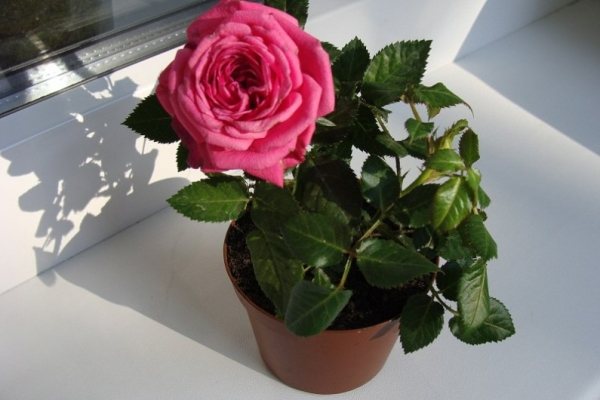

Transplant after parasite infestation
Quite often, when planning to transplant a room rose, the gardener discovers parasites on it. And here the situation is complicated at times. It is important not only to carefully move the bush to a new apartment, but also to prevent pests from moving with it.
Here you need to act according to the following scheme:
- Prepare the pot, soil and drainage - everything is as in the previous methods.
- Carefully remove the rose from the old pot and free its roots from the ground.
- Inspect the roots - they must be white.If they are black or brown in places, then they need to be carefully trimmed.
- Rinse the roots and top of the plant with soapy water.
- Place the root part of the bush in the Kornevin solution for half an hour.
- Transplant the rose into a new pot - place the roots in the center and carefully pour the earth in a circle to the desired level, crushing, but not tamping.
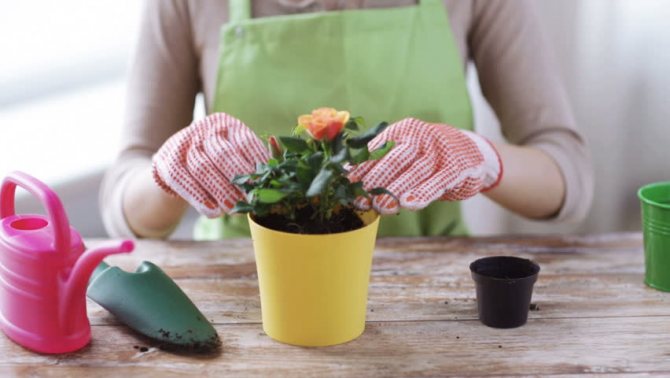

Transplanted plant care
Subsequent care for a rose bush of any variety consists of regular watering, feeding and pruning, as well as observing a period of winter dormancy. Here are some valuable tips for growing a whimsical flower at home.
- Watering a rose in a pot is necessary after the top layer of soil has dried. In spring and summer, watering should be abundant, in winter, moderate and rare.
- It is better to take water for irrigation warm, filtered or rainwater, it should be poured only at the root.
- The bush is fed with organic and mineral fertilizers, adding them in the summer 1 time a week when watering, in the fall - once every 2-3 weeks.
- In summer, the temperature in the room should be kept at around 20-25 degrees, in winter - about 10-15 degrees.
- If the apartment is dry and warm, every day the plant is sprayed with warm water from a spray bottle.
- It is advisable to place the pot on a lighted windowsill, regularly airing the room during the warm season.
- Before wintering, the flower must be pruned, removing the remnants of foliage and the tips of the branches. To form a beautiful crown, 5-6 buds should be left on each branch in the fall.
You should also regularly inspect a room rose to prevent it from becoming infected with various diseases and pests. When aphids, spider mites or spots appear on the leaves, treatment with appropriate drugs or folk remedies must be carried out.
For those who want to study in detail the information on how to transplant a room rose correctly, the video below with practical recommendations from an experienced florist will help.
Top dressing
Potted roses bloom almost all year round, which takes a lot of their energy. Therefore, plants need regular mineral feeding - every ten days with any universal or special complexes.
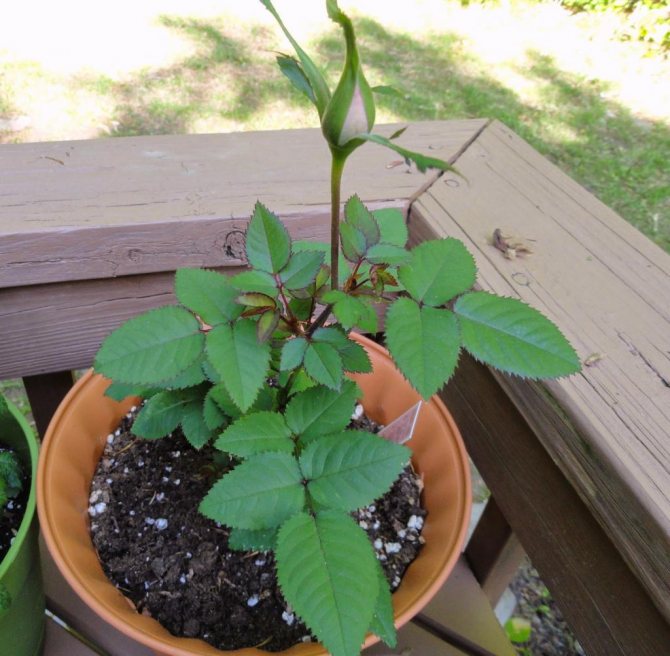

They also respond well to foliar feeding, so they need to be sprayed with Bon Forte or a similar product several times a year.
Fertilizers should be applied in the afternoon and after watering. After transplanting, potted roses are not fertilized - from a couple of weeks to a month.
Features of the procedure
When can and should not exercise?
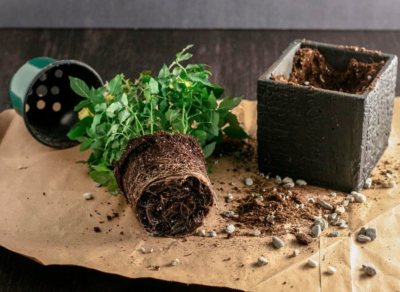

- You can transplant a room rose at any time of the year. It is possible in summer, since the air temperature in the room practically does not change. But many breeders recommend spring, as it should be in a cool room after transplanting.
- The procedure is performed after its flowering.
- An indoor plant cannot be transplanted on the day of store purchase. She needs to adapt to new conditions (what kind of care does she need after shopping in a store?).
Sometimes, the plant needs an emergency transplant.
Emergency cases
Reasons for an emergency transplant include:
- Overgrowth of roots.
- Flower disease.
What time to choose?
Spring is considered the right time, as mentioned above., since the air temperature in the room at this time is lower than in summer. For this process, you need to create cool conditions in the room, then the flower will take root better.
General characteristics
Indoor roses (also called "miniature") come from the Chinese rose Minima, which was brought to Europe from China in 1810. However, at first they were not very popular. Dutch breeder Jean de Vinck created a hybrid of a small Rouletii rose with a rose called Gloria Mundi. The created variety was named Tom Thumb, which in 1936 became the first patented room rose in the United States.
The average height of a room rose is 20-25 centimeters, some old plants can grow up to 45-50 centimeters. Flowers with a diameter of 1.5-2 centimeters, densely double, collected in inflorescences and rarely bloom singly.
The classic miniature rose is a small bush with carved leaves and rich, vibrant flowers that can be red, white, pink and bright yellow.


What affects the transplant time?
Seasonality
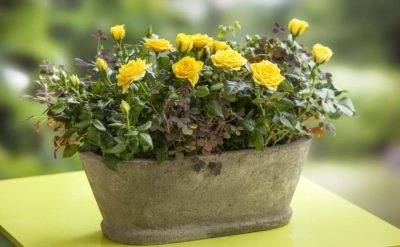

Indoor roses have life cycle phases. In the spring, buds wake up, shoots appear. There is an awakening from winter sleep. The flower enters the growing season. At this time, it is better to do the transplant.
When the weather is warm, the houseplant will bloom.... As we have already discussed above, during this period, the transplant cannot be carried out, since the rose can react negatively and drop the bud (why does the indoor rose drop leaves and buds and dries up?).
Learn more about caring for a room rose in winter here.
Type of plant
Different types of plants bloom at different times... Some bloom all year round, while others bloom in certain months. Most often, the buds are formed in the summer. Thus, the transplant is carried out depending on the time of sleep and flowering. This also applies to remontant varieties that bloom in winter.
Flower age
With proper care, a rose can live for ten years. When the plant is young, it is transplanted annually, changing the pot each time. This applies to a period of up to three years. Further, the transplant can be done in three or four years.
Is it possible to plant a garden rose in a pot at home. Conditions for home growing roses
What to expect when growing roses at home - to get a flowering bush in late autumn, winter or early spring. This can be achieved by growing the rose in a cool, bright room, like in a greenhouse. It is moderately warm, long daylight hours and high humidity. You can get such conditions at home. It is enough to put a rose on a window illuminated by the sun. Separate the plant from the heating devices with a foil screen, install additional lighting that prolongs daylight hours and periodically spray the bush with warm (2-3 degrees higher than the air temperature) water.
In the summer, indoor flowers are taken out into the street. The first days, depending on the weather, must be protected from the sun's rays. In the morning and evening hours, it is useful to spray the rose bushes with water. Such procedures refresh the rose, increase air humidity and reduce the risk of harmful insects. But it should be remembered that water procedures in cloudy weather should not be carried out, the development of the bush may slow down. In autumn, without waiting for frost, flowers are returned to the windowsill.
To properly grow roses at home in a pot, it is very important to maintain the optimal moisture content of the earthy coma. Watering must be sufficient so that water flows out of the drainage hole. You can leave water in the pan for no more than 2 hours, after which excess water must be removed.
The soil for potted roses should contain the nutrients and trace elements that the plant needs. A mixture of greenhouse humus, clay, sand and rotted manure is suitable as a nutrient soil. You can replace this mixture with a ready-to-grow rose, which is available at any gardening store.
The rose took root and bloomed. Is the goal achieved? No, you need to get another one, of a different type, variety, color.
How to carry out the procedure correctly?
After the purchase
After purchase, the plant cannot be transplanted immediately. He needs time to adapt, so that he gets used to new conditions. After the purchased flower has adapted, you can start transplanting it into another pot.:
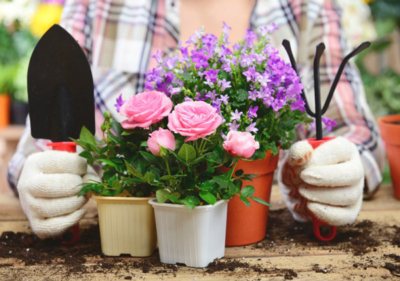

- We wash the flower with soapy water.
- We arrange a contrast shower. The water temperature should not exceed +40 degrees.
- We fill the pot with earth and put it in water for half an hour.
- We treat the upper part of the rose with Epin. It boosts immunity and stimulates plant growth. Preparing a solution based on the drug: add five drops of the drug to one liter of water. Shake and spray the flower. Then we wrap it in cellophane so that it does not touch the foliage. The procedure is carried out every day for a week, while we ventilate the built mini greenhouse.
After preparing the plant, we transplant it into a new pot with new soil.:
- We extract the rose from the ground.
- We place it in a basin with warm boiled water.
- Pour drainage into the prepared pot in a layer of two centimeters. Above is part of the soil.
- We take the rose out of the water and examine the roots. We cut dry roots with pruning shears, disinfect the places of cuts.
- Place the flower in the center of the pot and gradually add earth.
- We transfer the pot to a cool-dark place for one day.
- Watering is done two days after planting.
We offer you to watch a visual video with the process of carrying out a rose transplant after purchase:
After the outgrowth of the flower
To transplant an adult plant, you need to take:
- a pot with drainage holes;
- ready-made soil for indoor plants;
- drainage materials.
It is recommended to transplant an adult flower with a "shaft":
- You need to get the plant, observing the following recommendations: lower the pot down so that the stem remains between the fingers of the hand. Shake the pot. Thus, removing a houseplant will be painless.
- We put a layer of expanded clay, soil in a new pot. Then we place the rose and gradually sprinkle it with earth.
- After planting, shake the pot to compact the soil. Add more land if necessary.
- The first day we do not water the plant.
Roses in street pots. Growing roses in pots on the street
Roses in containers in the garden. 4 tips to help you grow potted roses in your garden. We will tell you when to transplant into the ground.
Growing roses in pots on the street
We grow roses in pots at home, and in the garden we are used to planting them in open ground. Florists buy and put roses in containers right on the street - why hide beauty. They do not transplant until the end of flowering.
What pots we take: purchased, plastic or decorative clay, plastic bags.
Rose transplant: in clay pots with glazed bottom and inner walls.
Transfer: after flowering.
We transplant large roses into rectangular containers or wooden boxes. We use the latter option if there are no transplant containers. We are waiting for the dormant period and we transfer the seedlings with a root ball. Before transplanting we enjoy roses in the garden.
Depth of rose pots:
- Dwarf varieties - a pot of 20-40 cm.
- Medium grades - from 45 cm.
- The roots are buried 15 cm in the ground.
Before transplanting, we leave the roses in a plastic purchased pot, but we will make one decoration - we will put them in a decorative pot.
4 ways to grow roses in pots:
- Place the store pot in a decorative container. We choose clay pots with artificial aging, or we find old chipped containers, in which flowers would not be planted.
- We fill the decorative pots with earth. We make a depression to fit the pot.
- We insert the pot into the ground.
- We hide the rims of the pot under the rims of the decorative container.


Transplanting roses into plastic bags
Instead of decorative pots, we use plastic bags with craft colors. We change plastic pots with drainage for bags. We fill the drainage layer at the bottom. Ordinary bags disintegrate - the plastic keeps its shape.
Lined with 4 layers of newspaper or paper inside. After temporary germination, take it out together with the protective shell and transplant it into the garden.
Land for growing roses in pots on the face
We continue cultivation in a purchased potting mix, or we collect land from scratch. Lay a 3 cm drainage layer at the bottom of the pot or bag.
Drainage layer for growing roses: gravel, small stones, vermiculite.
Use broken brick or clay shards if no other options are available. Lay the earth on top of the drainage layer. We collect the main ingredients from the garden or buy them. The shops sell soil for roses. We add sand and mineral components to the mixture.
We put the earthen mixture on the drainage layer, and make a depression the size of the roses. We transfer the seedlings into the recess and dig in with earth. We lay the top layer with peat moss to retain moisture. Remember that we carry out a transplant if the seedlings of roses in pots do not bloom.
Rose care:
- Lighting 6-10 hours a day.
- Direct lighting in the morning.
- Watering after drying out the earth.
- Top dressing with minerals and trace elements.
Technique for transplanting roses in pots
Deepen with a root ball. Immerse in the earthen mixture so that the roots of the plant remain above the ground.
We attach a seedling in a pot: we retreat 3 cm from the walls, plant in the center.
For tall seedlings, place a wooden stick next to it - along it, the stalks will trail upward. We are waiting for the weather to be suitable for planting potted roses outside.
↓ Share how did you grow potted roses on the street? Write when you transplanted, how you kept the roses before transplanting.
How to take care of home culture in the future?
After transplanting, the rose needs special care.


- To make it take root better and endure a stressful situation, cover the rose with the top of a plastic bottle. She remains in this state for seven days. At the same time, it must be regularly ventilated and watered. Watering should be minimal. Then we remove the cap.
- The temperature in summer should not exceed twenty, twenty-five degrees, in winter - ten, fifteen degrees.
- In a dry room, spray with warm water twice a day.
Thus, we considered the goals of transplantation, studied the instructions for performing this process and came to the conclusion that the rose is a delicate flower, so it must be transplanted carefully and all the rules must be followed. It is necessary to follow the rules of care after such a procedure.
How to plant a rose from a pot in the ground. Planting miniature roses in open ground
Planting roses from a pot
After clearing weeds, the site needs to be dug up, while applying a large amount of organic fertilizers. It is best to do this 3-4 weeks before planting.
Before planting, water your rose in a pot, set aside for a while, letting the water drain. If the compost or soil the rose is in is too dry, place the pot in a bucket of water and let the potting soil soak well. The planting hole should be large enough so that the roots are not squeezed.
Spread out the roots so they don't spiral in a new location. It is best to fill the hole in a few steps, gently trampling the ground after each new portion.
Many small and ground cover roses grow on their own roots, but if the plant has been grafted, the scion should be 2.5 cm below soil level. If you have received a seedling without soil and with bare roots in a dormant state, keep the roots of the rose moist until it is planted. If the soil is too wet or frozen, you can dig the bare-rooted rose into the furrow and sprinkle it with earth to help wait for better planting conditions.
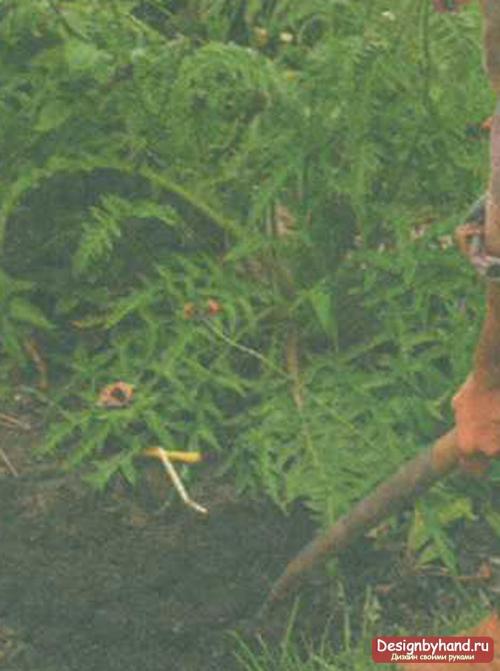

Dig a planting hole the same depth as the pot in which the rose was grown, the width should be twice the width of the pot.
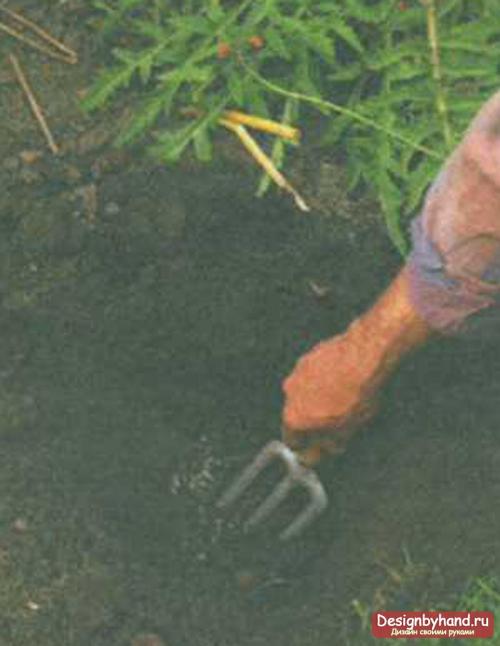

Loosen the soil at the bottom of the hole with hand forks and apply a layer of slowly dissolving fertilizer to the bottom.
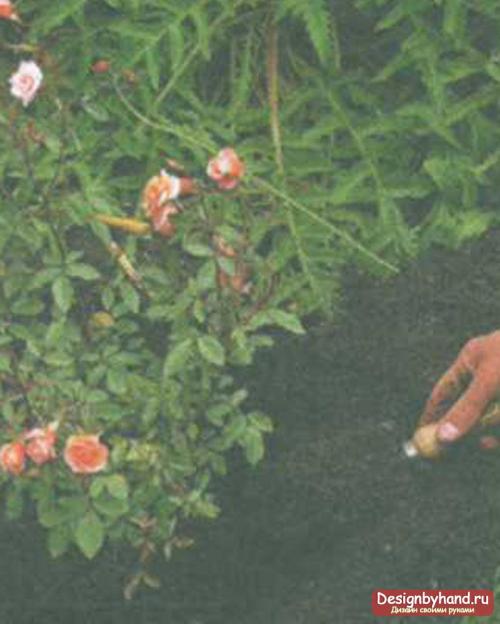

Fill the dug hole with soil in two or three steps, after each falling asleep, gently trample it.
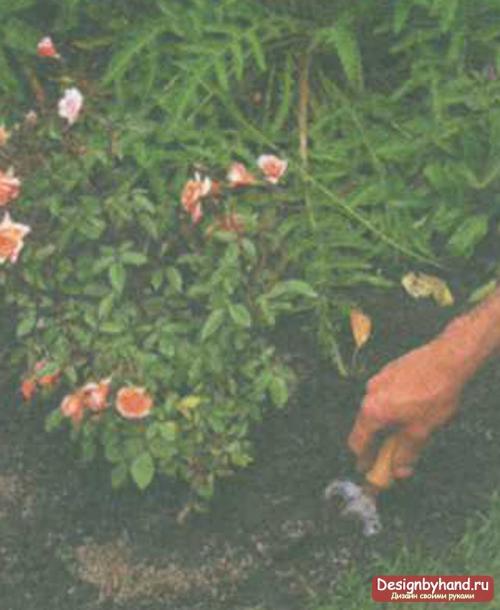

Pour another layer of slowly dissolving top dressing on top around the root zone, observing the proportions indicated by the manufacturer, dig up the area treated with fertilizers with a pitchfork.
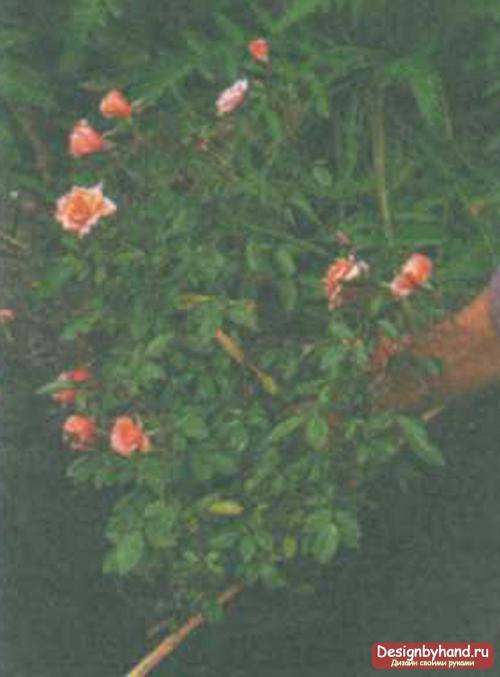

Place the potted plant in the dug hole, and with a stick on the edges of the groove, check that the depth of the hole matches the size of the rose. The stick should barely touch the compost or soil in the pot.
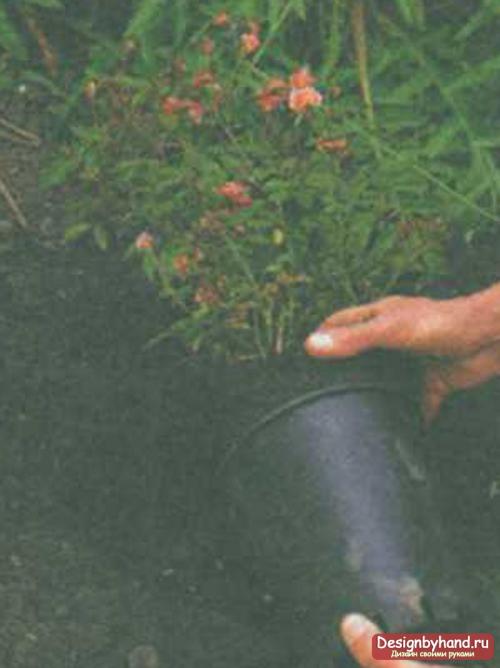

Gently push the rose out of the pot along with the soil, gently spread the roots. Place it in the hole, spread the roots evenly throughout the hole.


Pour thoroughly and abundantly from a watering can with a fine nozzle so that the top layer of soil does not wash off and rise.
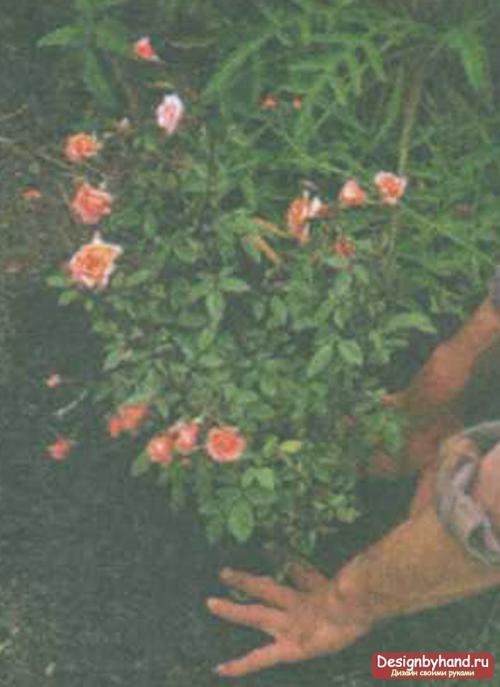

Add 5-8 cm of organic mulch around the roots to help retain moisture and inhibit weed growth.
If you are the author of the photo used in the article, write to us, we will definitely indicate the authorship!
Useful video
We offer you to get acquainted with an informative video on when and how to properly transplant a room rose:
If you find an error, please select a piece of text and press Ctrl + Enter.
No special skills are required to transplant a room rose. If you know some of the features and follow the advice of experienced florists, then this queen of flowers will delight you for a long time.
Roses. Illustration for this article is used under a standard license.
Most popular varieties
Indoor roses include many varieties, the most popular of which are the following:
- Tea rose. Many Bengali varieties have been used to breed it. This rose is quite large and can grow up to two meters. And on the basis of this, some have a misunderstanding of how to transplant a room rose with such growth. There is nothing complicated in transplanting - the procedure is carried out in the same way as for smaller roses. Although there are also miniature species that are 20-25 centimeters high. The tea rose is perfect for growing at home, because it was bred for this very purpose.
- Chinese rose. This variety is characterized by the presence of small flowers that cover almost the entire bush. It is popular precisely because of its decorative features.
- Bengal rose. The rose stands out among other varieties in the absence of an odor, which can occasionally be perceptible. The absence of an exquisite smell is compensated by a wide palette of saturated colors. This variety is especially unpretentious to care for, because it is usually not even pruned, only if the branches are dry and painful.
- Bourbon rose. It is distinguished by its large flowers, which can delight gardeners from summer to December, after which it goes to winter rest. After hibernation, the rose comes to life again by April.
- Repaired rose. This variety is famous for its unpretentiousness. The flowers are small, but they can be very different in color. The advantage of the remontant rose is that it blooms all year round.
- Rose Baby Masquerade. The color of the roses changes over the entire flowering period from bright yellow to deep red. Therefore, they are also called chameleon flowers. This rose also lacks thorns and has a fruity scent.
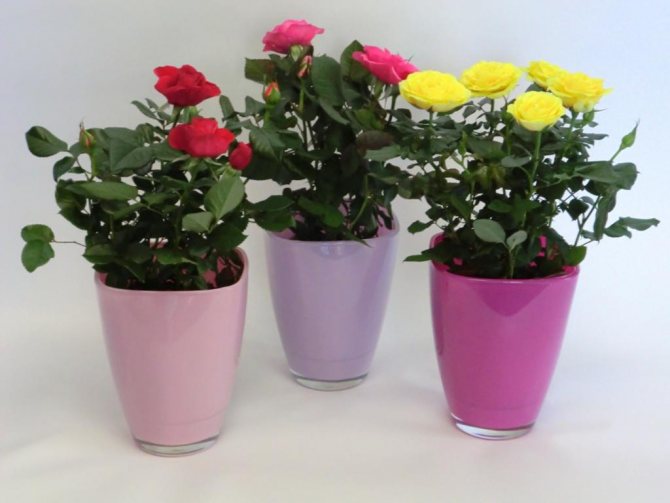

Why do you need a transplant
A store-bought indoor rose, as a rule, is planted in clean peat or other filler that lacks nutrients. And to give a decorative look to the plant, manufacturers feed it with special means, the name and composition of which cannot be recognized.
Leaving your flower in such soil means ruining it. The fact is that at home the plant is watered with plain water, which causes acidification of peat and the occurrence of infectious diseases. The leaves and twigs of the rose turn black, rot and eventually die. However, by transplanting a rose, you can achieve that it will delight you with its blooming appearance for a long time.
Temperature
Indoor rose does not tolerate heat well. After you have learned how to transplant a store-bought rose and have done so, place the flower in the most favorable place for it. The most suitable temperature for a rose in the summer is 20-25 degrees above zero.It is worth knowing that a miniature rose should never be placed near heating appliances. In winter, the temperature should reach 10-12 degrees Celsius. In the cold season, the rose is recommended to be placed on a glazed loggia or balcony.
Advice! If in winter the rose is in a glass loggia, then it is better to put the plant in a box and sprinkle sawdust around it to avoid freezing the soil.
Preparing for transplant
The need for a flower transplant does not mean that it needs to be done right away. Once in a new place, he must get used to new climatic conditions.
Rose bushes. Illustration for this article is used under a standard license.
The only thing that is allowed right away is to wash the rose. To do this, you can use a bowl of warm, soapy water. The plant is dipped into it directly with its head for half an hour. After that, it is recommended for the rose to organize a contrast shower, alternating warm water with hot (no more than + 40 ° C). And at the last stage, spray and pour water with "Epin" (at the rate of 5 drops of the product per 1 liter of water).
As soon as the water drains, the rose is placed in a greenhouse made from a bag. A regular plastic bag, which is pulled over the props, will do. At the same time, it is necessary to ensure that the polyethylene does not touch the leaves. So the flower is left for several days, regularly airing. Every day, the time for hardening procedures is gradually increasing.
Reasons for transplanting roses
Sometimes, having planted a plant on a site, you have to transplant it to another place.
Consider the main reasons for the transplant:
- Depletion of the soil under the plant. Over the years, the soil in the place set aside for roses consumes all useful elements and trace elements. And even the introduction of mineral fertilizers does not save the situation.
- Redevelopment of a flower garden or changing the landscape design. A single rose bush may not match the new color scheme and stand out from the whole composition. In addition, new construction projects are being added on the site. Then a decision is made to move the plant or the entire rose garden to another place.
- The grown rose bush has become very large and interferes with the normal growth of other flowers. Sometimes it becomes necessary to transplant old bushes from the foreground, which are constantly sick or bloom poorly from year to year.
It is recommended to replant roses no more than once every 3-5 years. This time is required for the plant to take root and grow new roots.
How to transplant
When the flowers begin to wilt, they are removed. After that, the rose is removed from the container by placing it in cooled boiled water. This is to ensure that no transport soil and any chemicals remain on the roots. The latter are introduced to preserve the miniature state of the flower, which does not allow it to grow and develop.
If the root system is wrapped in a special cloth, then it should be removed. In this case, care must be taken not to damage the roots.
After freeing the root system from the soil, the rose is placed in a previously prepared separate pot. It is not worth taking a large container at once, otherwise you will have to wait a very long time for flowering. A pot that is only 5 cm higher than the previous “dwelling” of the rose in height and 3 cm in diameter will do.
The soil for the flower is prepared in advance. Roses prefer loose, well-drained, slightly acidic or neutral soil. It is best to purchase it in a specialized store. If there are no drainage holes in the pot, then they must be made. After that, a 1 cm thick drainage layer is poured onto the bottom of the container. Expanded clay is perfect for this. It is necessary to plant a flower at the same depth as in the previous pot.
How to plant a room rose
Before transplanting, the bush must be cut off, that is, the buds, dried leaves and too long branches are removed. The remaining shoots should have 3-5 buds, from which new greens will appear in the future.At the same stage, it is necessary to form a crown, since bushes growing freely in all directions look wild and untidy.
As a result of such pruning, there are many branches that are a pity to throw away. You can try to plant them, that is, grow a new bush from each branch. In theory, every cut off shoot is capable of taking root - both old thick and small green ones. But practice shows that not all of the cut branches are capable of taking root, so when planting, you need to take in quantity and place all suitable material in the water.
The roots will not appear immediately - it takes from one and a half months to six months before the shoot finally comes to life. After the initial root system has formed, the plant must be transplanted into a pot.
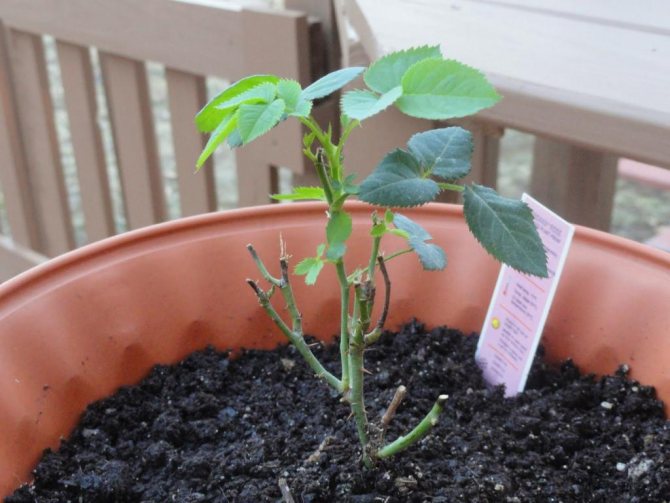

Pruning
This procedure is necessary to stimulate the ovary. During flowering, it is required to cut off wilted flowers. During the planned order, the flower is cut in the fall to prepare for rest. This is also done in the spring.
Pruning is carried out with a sharp tool so that there are no torn parts on the branch, this can lead to the death of the flower. The procedure is performed until healthy tissue, above the kidney. An oblique cut is made approximately 5 mm above the kidney.
Weak or dry shoots and those that lack the upper bud should be removed. With the interlacing of two shoots, one must be removed. After pruning, two stems are formed from one bud, the extra ones are cut off. You should not carry out spring pruning until there is ten hour daylight hours, otherwise the young shoots will not develop normally.
Why is the procedure required
A room rose needs to be transplanted:
- to maintain a healthy look;
- prolongation of flowering time;
- elimination of pathogens;
- enrichment of the soil with valuable components.
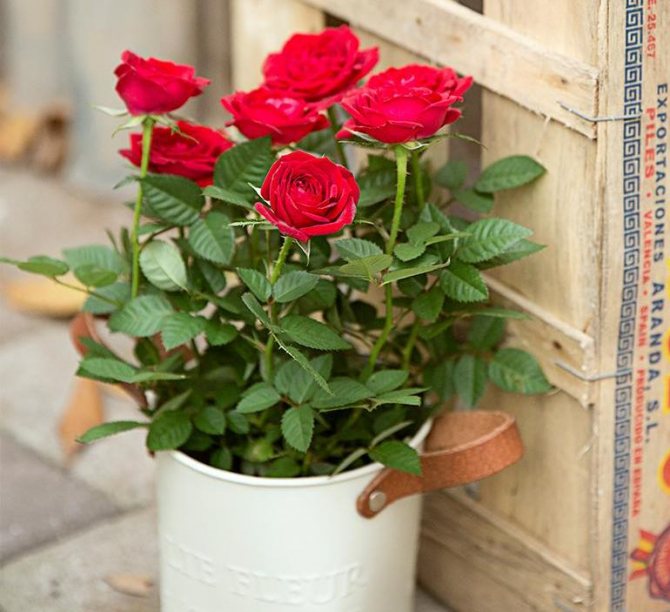

Whatever the purpose of the procedure, it must be performed correctly. Then the rose at home will have a neat, blooming look.
Output
Indoor rose is the queen of window sills. Many growers will agree with this. After all, its abundant flowering pleases the eye, and its pleasant aroma is unforgettable. In order for it to delight you with frequent flowering, you need to know how to transplant a room rose into a pot correctly, to provide it with proper care.
It often happens that a birthday boy or girlfriend is given a miniature plant in a small pot instead of a bouquet of roses. Cut flowers wither after a few days, and such a sign of attention allows you to enjoy bright buds and long flowering for a long time.
However, those who want to preserve the beauty and healthy appearance of the plant need to know how to transplant a room rose after purchasing it in the store. Vendors water the flowers with special fertilizers for distillation, and changing conditions of detention often goes to the detriment of a lush bush. We will consider in the article all the stages of a simple procedure, we will give recommendations for transplanting into another pot.


Site preparation
The key to beautiful, healthy roses is their correct planting. If you make mistakes when transplanting, then over time you will have to solve much more problems, and it will take a lot of work. The question of whether it is possible to transplant roses without preparing the place worries many. The answer to it is simple: if you want to get a lush flower bed, then the soil should be fertilized and loosened in advance.
It is better to start preparation a month before replanting the roses themselves. The selected area is dug up and weed roots are removed from the soil. Next, you need to fertilize the ground. To do this, you need lime and fertilizers that can saturate the soil with useful substances. The treated soil must be left in absolute rest for a while.


By the time the roses are planted, it is recommended to re-dig the ground prepared in advance. Dig holes under each bush. A drainage layer and fertilizer are poured into each planting hole, after which a bush can already be planted.
To facilitate the process of the first digging and harvesting of weed roots, you can use another method: lay newspapers on the selected area (approximately you need a layer of 10-12 sheets), fix them with stones so that they do not fly away. In a couple of months, under the newspaper, the grass will die and rot. This will make the soil soft and healthy for new plants.
Pot and soil
Roses are planted in containers of different shapes and sizes. The only condition is that there is sufficient space for development. The air must have free circulation. A heavily overgrown plant must be transplanted into large containers.
When buying a pot, you need to take into account the color of the flowers and the style of the interior. The best are wooden and ceramic containers. You can use plastic ones, but they are not very reliable. The soil in them dries out quickly in summer, which contributes to the rapid withering of the buds. Clay pots should not be chosen as they quickly lose water.
It is important that the soil is air and moisture permeable. You need a nutritious substrate:
- from sod land - 4 parts;
- humus - 4;
- sand - 1.
You can also buy a ready-made substrate. The pot must have a high-quality drainage system so that excess moisture can freely pass through the soil. But the size of the drainage holes should be such that the water does not go away very quickly.
Top dressing and fertilizers
Due to the fact that the rose is able to bloom for a long time, and some varieties do all year round, it needs feeding the earth. Usually, the period when you need to fertilize the rose begins at the end of February with a frequency of once every ten days.
- It is best to use mineral and organic fertilizers as top dressing.
- When the plant starts growing, it is necessary to add complex mineral fertilizers to the soil every week.
- It is best to fertilize middle-aged indoor roses with a solution from a spray bottle without affecting the root system of the flower.
- Experts do not recommend fertilizing roses recently transplanted into fresh soil and flowers that are currently sick.
Advice! Before starting to carry out the feeding procedure, the rose must be watered with warm water.
What materials are needed
If we are talking about a recently purchased plant, its transplant is carried out no earlier than two to three weeks after it appears in a new place. In the absence of signs of wilting and disease, you can start transplanting. There is no need to choose a pot that is too large: there will be enough capacity a couple of centimeters larger than the previous one. If it is too large, the beauty will definitely not bloom in the next couple of years, because all of its growth will go into the greenery and into the root system, preventing the buds from tying.
Soil for a room rose can also be used in a store designed specifically for it. Sometimes experienced flower growers prepare the soil composition themselves, but it needs preliminary disinfection and the presence of certain components that not everyone can get on their own (peat, fertile weakly acidic soil, humus, manure).
Therefore, buying soil in a flower shop is the best option, especially since all the land that goes into retail has been previously disinfected and does not pose a danger to indoor plants.
The pot must have drainage holes. If they are not there, then this is a pots, and you will have to make the holes yourself. It's good if it turned out to be made of plastic: then a screwdriver hot on a fire will help. In the case of ceramic pots, unfortunately, you will have to buy another container again.
When is it better to do it?
Indoor rose can be transplanted at any time of the year. This is possible because there is no significant temperature difference in the apartments depending on the season. Of course, it is advisable to transplant in the spring.It should be borne in mind that care after transplanting in the summer is quite difficult to provide, because at first the rose should be in a room with a low temperature.
The plant may need an emergency transplant. The reasons for an urgent transplant include:
- Overgrowth of roots;
- Flower disease.
What materials are needed
To carry out a successful procedure, you need to prepare all the materials necessary for this manipulation.
What you need to have in stock:
- An appropriately sized ceramic or plastic pot.
- Fertile soil.
- Drainage material.
When choosing a pot, you need to take into account that it should be several centimeters larger in size than the pot in which the flower was bought. This will allow the plant to grow freely.by regularly increasing the root mass.
But do not buy too large a pot, this will provoke the plant to grow actively, not thereby allowing new buds to be tied, but for a rose this is irrelevant, since this flower is acquired precisely because of its charming flowering.
Of course, it is better to buy the substrate in a store where this particular flower is indicated on the package. Moreover the purchase must take place in a specialized flower shop or the garden centers of a large supermarket. This ensures that in the bag with soil there will be a mixture that corresponds in composition to the parameters stated on the package.
If there is no such specialized land, then you can choose the soil yourself, although this is not recommended. It should be loose and have both neutral and slightly acidic reactions.
Buying a ceramic pot entails small procedures that need to be done with him, before transplanting a flower into it. It must be completely immersed in water for several hours.
Make sure the pot has drainage holes. If they are not there, then this is not a pot, but a pots. In the case of a plastic product the problem is easy to fixby heating a screwdriver on the fire and making holes in the bottom. If the product is made of ceramic, then it is not suitable for planting and you need to purchase another container, more suitable for transplanting.
Classification - varieties and species
The need for a garden classification system is due to the development of the science of selection. Acquaintance with the classifier allows breeders to continue their work on breeding new varieties of the "queen of flowers", and amateur flower growers, to properly care for their very capricious green pets. Without going too far into the abyss of breeding science, all currently existing species can be conditionally divided into several groups and classes, depending on the presence of stable garden traits.
The first version of the classifier was created and approved by the American Rose Society in 1976. In 2000, in a slightly modified and supplemented form, the classifier was published in Modern Roses. In accordance with this version, all roses can be divided into the following types: old, wild and modern garden roses, with subsequent gradation into certain groups depending on the color and number of petals.
What are the problems with growing?
If you do not follow the watering regime, the flower can infect fungal infections. Humid, cold and stagnant air are good conditions for the development of powdery mildew. In this case, the leaves are covered with a whitish bloom, wither and fall off. To combat the disease, solutions of a fungicide, copper sulfate or colloidal sulfur are used. Another fungal disease is rust. It manifests itself in reddish-brown spots on the leaves. Infected bushes begin to develop poorly. The plant should be treated with iron vitriol, Bordeaux liquid, copper chloride.
Black spot is not uncommon. The fact that the flower is dying and affected by such a disease is indicated by multiple brown-black spots on the leaves.The disease usually appears with waterlogging and nutrient deficiency in the substrate. To rid the rose of spotting, the damaged areas are cut off, and the plant is treated with copper-containing agents.
Many growers are faced with the fact that the leaves of the Bengal rose turn yellow, dry and fall off. What to do? The reasons for this condition may be:
- Diseases.
- Pests.
- Deficiency of potassium, iron.
- Oversupply of fertilizers.
- Natural aging of the plant.
- Drafts.
- Bright lighting.
- Low humidity level.
- Improper watering.
If you carry out prevention in a timely manner, properly care for the Bourbon rose, there will be no problems.
Thus, a home rose in a pot is a decoration for an apartment. The content of the plant is simple. But in order for a flower to grow well, it needs to be properly looked after. It is important to constantly inspect for the presence of diseases, pests and, if necessary, take measures for treatment and protection.
What could be more beautiful than a fresh blossoming pink bud, yes, and not somewhere on a flower bed or lawn, but on your windowsill? To breed a real rose garden in your apartment, perhaps you just need to know how to properly care for a whimsical plant so that it delights you with its flowering longer.
Soil for planting
Indoor rose is a finicky plant. She is very demanding on the composition of the soil. If it is planted in the wrong soil, it may stop growing, and it may not bloom at all. So how to transplant a rose in a pot after purchase?
It is better to purchase a ready-made soil designed specifically for roses. In flower shops, you can easily find the necessary substrate.
But you can also prepare the soil yourself. To do this, it is enough to mix humus, turf soil and sand in a ratio of 4: 4: 1. Florists also recommend adding a little expanded clay to such a soil mixture, which will contribute to the air permeability of the soil.
Immediately before planting, the plant must be watered well and left for 20-30 minutes so that the water is absorbed into the soil.
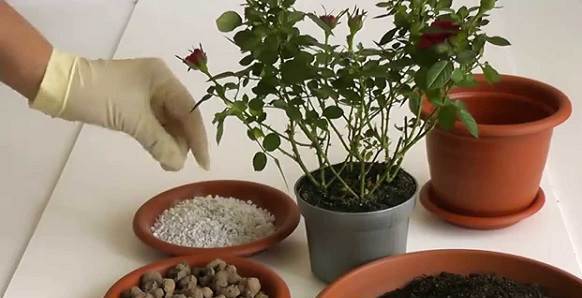

Gallery: mini rose (25 photos)
Reproduction of rose bushes at home
Landing can be done in several ways:
- using seeds;
- by vaccination method;
- by cuttings.
The most optimal and effective method of the above is to grow roses from cuttings. In order for the reproduction procedure to be successful for the cutting, you need to choose a stem with a formed bud.
Such samples are the most persistent, since they contain the maximum possible amount of nutrients needed for the development of the plant's root system. Undoubtedly, there are cases when it was possible to grow a rose bush from a flower included in an ordinary store bouquet, but such precedents are very rare.
So, when choosing a stalk for planting, you need to pay attention to its length, its optimal indicator is about 30 cm.Further, you need to make an incision at a minimum angle of inclination, remove the bud and leaves with a sharp knife.
After performing these manipulations, the cutting should be left in a container of water for 10-15 minutes. Next, you need to process the sections (lower and upper) with potassium permanganate. Before planting the cuttings in the ground, the preparation process of which is described in detail above, it must be kept for 24 hours in a weak solution of heteroauxin. To prepare the solution, it is recommended to adhere to the following proportions: 1 tablet per 1 liter of settled water. Heteroauxin can be replaced with potassium permanganate.
After planting the cuttings, you need to create a greenhouse. You can use plastic wrap or a cut plastic bottle for this purpose. Watering, spraying should be carried out daily, but in such a way that the root system does not rot.
After some time, when the first leaves appear on the handle, the greenhouse can be removed.To strengthen the root system, flower growers recommend cutting the buds in the first year after the growing season.
First care after transplant
- Temperature... The optimal temperature regime in summer is 20-25 degrees, in winter - 10-15 degrees.
- Air humidity... In a dry room, a room rose needs to be sprayed with warm water 2 times a day. No need to spray in a cool room.
- Lighting... Indoor rose is a light-loving plant, so you need to grow it on the windowsill of the east and southeast windows. In the spring, the flower can be supplemented.
- Top dressing... During the period of active growth, you need to feed a room rose once a week. Fertilizers should be applied alternating organic and mineral.
- Watering... Watering a room rose should be done as the earth dries up. The plant treats overflow very badly, because it can lead to acidification of the soil. The flower is watered at the root.
We offer you to get acquainted with an informative video about caring for a room rose after transplanting:
We talked about all the nuances of caring for a room rose here, and from this article you will learn how to create conditions suitable for a plant in winter.
Growing a room rose is a very difficult task. But this does not prevent many gardeners from observing all the conditions to provide it with everything necessary. After all, everyone wants to have a lovely rose with graceful flowers and an unusually pleasant aroma in his house.
If you find an error, please select a piece of text and press Ctrl + Enter.
Summer
It is not recommended to change the place of flowering bushes. But there are situations when roses have to be transplanted in the summer. The main thing is to follow simple rules so that the plant does not die:
- At this time, you will have to sacrifice the flowering of the plant. The bush is pruned to 40–45 cm, the emerging inflorescences and blossoming buds are removed.
- It is better to choose cloudy weather so that the direct rays of the sun do not fall on the transplanted rose. Or replant them in the evening.
- Prepare a hole for a flower. Add fertilizer and let the soil sit for a few days.
- During transplanting, it is recommended to keep as much soil as possible on the root system of the bush. In no case shake it off the roots.
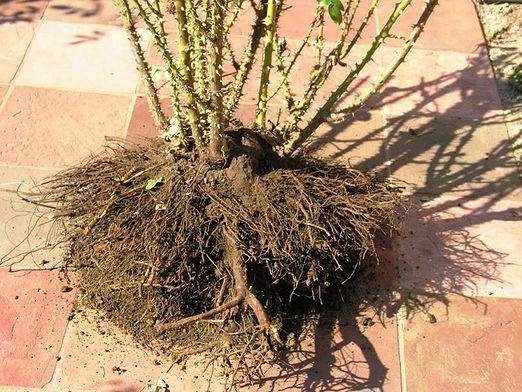

- Watering the bush is carried out daily for a month. It is also recommended to cover the rose from direct sunlight until it takes root, as they adversely affect its condition.
Observing these rules, you can transplant a rose in the summer, but the chance of its successful survival depends on further care during the first month.
Necessary preparation
The wrong place is one of the main reasons for transplanting roses. This time, consider all the requirements of the plant:
- open area or light partial shade (for varieties in which the petals fade in the sun);
- fertile, loose, slightly acidic substrate;
- lack of reasons for stagnation of water (lowland) and / or close (1 m or less) groundwater approaching the soil surface;
- availability of protection from cold winds.


Most roses need the longest possible daylight for long and abundant flowering - keep this in mind when choosing a place for transplanted bushes.
A planting hole with a depth and diameter of 0.5–0.7 m is prepared at least 2 weeks before the procedure. The easiest way is to fill it with purchased soil for roses, but you can prepare a soil mixture yourself from fertile turf, peat crumbs, humus, sand (2: 1: 1: 1) and a liter can of wood ash. At the bottom, a drainage layer 5–7 m thick is required. A deoxidizer is introduced into the acidic soil - dolomite flour or ground eggshell (100 g per pit), in alkaline soil - sawdust of coniferous trees (about a glass). It is not recommended to add mineral fertilizers when transplanting roses.
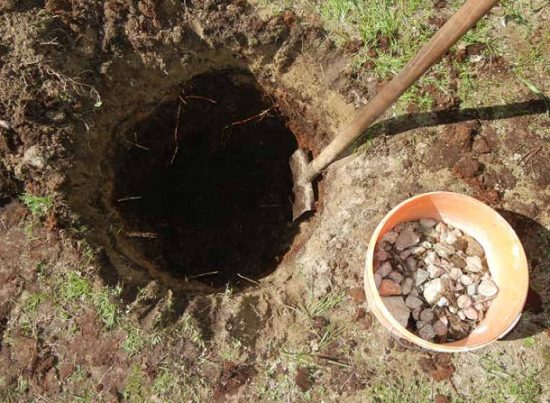

Drainage at the bottom of the planting pit will prevent water from stagnating at the roots of the rose - the plant is very sensitive to this, rot develops quickly
Plan the area of the site in advance if you transfer several bushes to a new place. The intervals between them depend on the size of the rose of this variety. On average, for hybrid tea, polyanthus and floribunda roses, 0.4–0.6 m is enough, for park - 0.8–1 m, for climbing and standard roses - 1 m or more.
How to root cuttings of roses
When the seedlings have root embryos, you can start rooting them. If you do this at home, you will need pots that have been pretreated with potassium permanganate solution and filled with drainage and special soil.
Note: As drainage, you can use small pebbles or other material that allows water to pass through well. A special soil for roses is laid on top of the drainage. Ordinary sod land is also suitable for this purpose. The top layer of soil is sprinkled with washed river sand.
The seedling must be inserted into the sand, making sure that its lower edge does not touch the ground. If you are not using a pot, but a box as a container, leave a distance of 8 cm between the shoots. Still, it is better to root the plants separately from each other.
Provided planting in a garden, the stems are dropped at an angle into the holes previously disinfected with a solution of potassium permanganate, deepening the lower bud into the ground. The planted sprouts are watered and covered with a glass jar.
Sprouts continue to root at a daytime temperature of at least +25 for another month. Next, hardening begins by removing the cans for a while. Soon, the banks are removed altogether.
Before the onset of autumn, young shoots grow up to 30-40 cm, and on some buds have time to form. In this case, they must be pinched to stop the flowering process, which inhibits the formation of roots.
In pots
After planting the sprouts in pots, they must be sprinkled with water and covered with a cut plastic bottle or plastic bag to maintain a certain temperature regime (Figure 4).
Containers with rooting seedlings are kept in a sufficiently warm place (+ 22 + 25), away from direct sunlight. It is important to maintain high humidity by spraying the sprouts from time to time.


Figure 4. Seedlings after rooting in pots
As soon as you notice small sprouts in the axils of the leaves, this is a sign that rooting has been successful. From this point on, you can begin to harden the plants, removing the shelter for several hours and controlling the moisture of the soil.
In water
To germinate seedlings in water, it is necessary to lower the cut stems into a container filled with water or a special mixture and keep in a warm, bright place for two weeks. It is during this time that the first roots should appear (Figure 5).
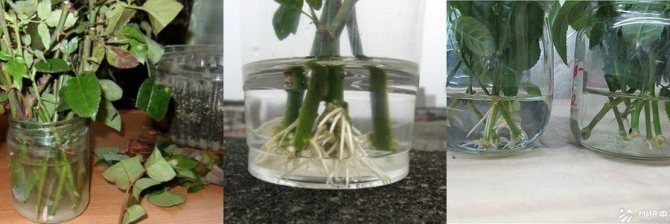

Figure 5. Germination (rooting) of sprouts in water
Germination in water is the easiest, but far from the only way to get planting material at home. Below it will be described what other means can be used for germination.
In potatoes
How to plant a rose in a potato at home is of interest to many flower lovers. This is a very interesting rooting method.
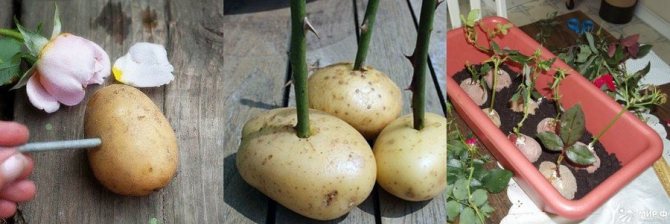

Figure 6. Rooting cuttings in potato tubers
The essence of the method is as follows: a hole is made in a medium-sized potato for an escape. Then a seedling is inserted into the potato and planted in the ground (Figure 6). At the same time, potatoes not only keep the sprout moist, but also nourish the plant and also protect it from diseases.
Roses in culture
The first roses began to be grown and selected by the ancient Romans. In the works of ancient Roman writers that have survived to this day, about ten varieties are mentioned, today their number is measured in hundreds of names.
Rose is a collective name for varieties and species of plants of the genus rose hips, which have long been cultivated by people.Most of the currently existing varieties of climbing and bush roses were obtained by the method of selection, through multiple crosses and painstaking selection, while some varieties are variations of the forms of wild species.
What a beginner needs to know before buying a potted rose
The quality of flowering does not depend on the number of inflorescences of the plant. It is very important that the flower has many young shoots. Their quantity and healthy appearance indicate that the rose feels great in the proposed conditions. In addition, such a plant takes root more easily during transplantation. But this procedure does not end with caring for a home rose.
Before starting to grow a rose in a pot at home, a beginner should know:
- how to adapt the plant to room temperature;
- how to carry out a contrast shower;
- what pests and diseases can affect the plant.
A rose, like a flower in a pot, is very moody and requires close attention. A novice florist may face difficulties immediately after buying a plant, bringing it home. Lush flowers that delight the eye on store shelves owe to special stimulants, the action of which is short-lived. Even the packaging of these flowers contains moisture stabilizers. Without these funds, the plant can dry out quickly. To prevent this from happening, you need to take some precautions:
- as soon as the rose in the pot gets home, it must be removed from the packaging, which helps to retain moisture, provoking the development of fungal diseases;
- you need to immediately cut off the spoiled leaves;
- the bearing stem and buds are recommended to be removed, in the same way as for a bush rose after purchase;
- if there are several plants in one pot, then they need to be planted;
- the rose should be treated with antifungal agents such as fitoverm or phytosporin. Also, these preparations are sprayed on the plant to get rid of pests.
Growth in a new place
If the planting is carried out on a flowerbed with already formed roses, it is necessary to fulfill some conditions that will help the new plant more easily adapt to the neighborhood and environment:
- varieties should approximately coincide in terms of flowering, so fast-growing neighbors will not dominate and hinder the growth of a new neighbor;
- if planting occurs in the fall, then neighboring bushes can also be pruned;


- watering and complementary feeding of the entire flower bed must be performed simultaneously, this contributes to the stimulation of the same growth rate of the rose garden.
To ensure optimal rooting of the rose, you can cut new shoots for the first one or two seasons, preventing the plant from blooming. Similar measures should be taken for neighboring bushes, creating uniform conditions for formation. In order for a newly planted bush to successfully winter, it is necessary not to forget to cover the roots before the onset of cold weather. For shelter, you need to loosen the soil, remove all young shoots and leaves with a pruner and cover the bush with wintering material. For high-quality protection from frost, spruce branches, spruce sawdust or specialized synthetic material are perfect.
The efforts spent on replanting roses and arranging a new place will justify themselves with lush flowering and magnificent aesthetics that will decorate the infield for many years.
Step-by-step instructions for transplanting a houseplant
For transplanting, you need to prepare a pot, potting soil, drainage.
Vessel


A new pot must be chosen larger than the one in which the rose is grown. Its overall dimensions should be 3-5 cm larger than the previous one in bottom diameter and 5-7 cm in height. It is better to choose a ceramic product with glazing... If such dishes are not available, then you can take a plastic container with thick walls and a large tray.
It is best to give preference to a classic pot or a slightly rounded shape. These features are very important when transplanting. If you choose a very large pot, the water will stagnate and acidify the soil.As a result, you may not see flowering at all.
Priming
Land can be purchased at the flower shop... For roses, there is a special soil that is ideal for them. Drainage mixtures are also purchased together with the soil. The soil can be prepared at home.
From one container to another - an algorithm of actions
Adult plant
- Prepare a pot for transplant... To do this, soak the product in warm water for 2-3 hours. If you use a pot in which another plant was grown, it should be rinsed thoroughly. No need to use detergents. Use regular baking soda to cleanse. Plastic pots do not need to be rinsed.
- Place drainage on the bottom of the pot... In pots without holes, the drainage layer should be at least 3 cm. In pots with holes, at least 1 cm. You can use a ready-made drainage mixture or use improvised materials. Expanded clay, pebbles, polystyrene and clay cuttings are suitable.
- Prepare land for replanting... Rose primer is sold at any flower shop. You can prepare the potting soil yourself. There are several mix options.
- 2 parts of clay-sod land;
- 1 part sand;
- 2 parts of peat or rotted manure.
- 1 part peat;
- 4 parts of sod-humus land;
- 4 pieces of sand.
In both compositions, you can add granules of any complex fertilizer for roses. Also, many add fine expanded clay to the soil.
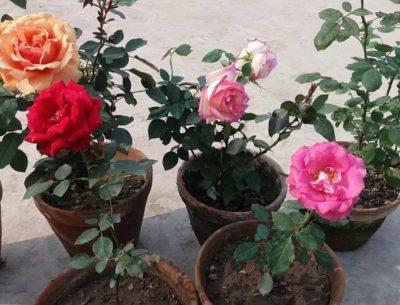

Before planting, the shoots of the rose must be cut off so that only 2-3 buds remain on each.- The transplant itself is reduced to the transshipment of an earthen coma. It must be handled very carefully, because the roots of the rose are very thin and fragile. Therefore, new soil is laid at the bottom of the pot, following the drainage.
Experienced gardeners recommend getting the plant out of the old pot in this way:
- Turn the container over, passing the stems of a room rose between your fingers, and shake it vigorously. So the flower is less worried.
- Before removing the pot with the plant, it is better to place it in water for several hours so that the earth is well saturated.
- Carefully place an earthen lump on the drainage layer. Then you should also add earth so that there are no voids around the edges.
We offer you to watch a visual video with the process of transplanting a room rose:
After the purchase
Transplanting a room rose immediately after purchase differs from transplanting an adult plant at home only in preparation for the procedure. Let's figure out how to transplant a purchased flower and what is important to remember. Such the plant can be transplanted without waiting for the end of the flowering period.
- Before transplanting, the rose must be washed with soapy water. This will help in the fight against parasites.
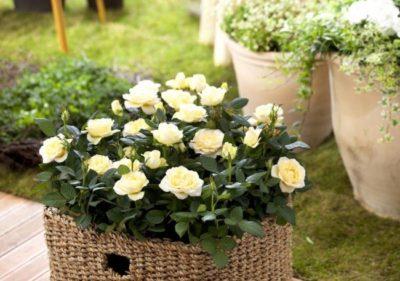

After that, the plant must be left in a bowl of cool water for 30 minutes. Then it is recommended to arrange a contrast shower for the leaves, alternating cold water with hot. The hot water temperature should not exceed 40 degrees.- Spray a room rose with an epin solution from a spray bottle. Cover with a plastic bag so that it does not touch the leaves.
- Once a day, you need to arrange ventilation, increasing its time.
- After all the manipulations, the flowers will fall off, and the plant can be transplanted.
You will find more information on caring for a room rose after purchase in this article.
Diseases and pests of the flower
All plants, including domestic ones, are susceptible to various diseases, as well as attack by pests. Therefore, every florist needs to be ready for this and know what to do in such cases.
A solution for processing a flower from spider mite you can cook it yourself. To do this, take 20 g of onion husks and pour water (1 l), leave for 24 hours. Strain the ready infusion and thoroughly rub each affected rose leaf with it. A day after the procedure, the foliage is washed with settled clean water. Continue the treatment until the tick disappears completely.
Powdery mildew:
- reasons: waterlogged soil;
- symptoms: yellow spots appear on the leaves, gradually increasing in size and acquiring a brown tint;
- actions: treat the foliage with a solution of soda and water in a proportion of 2 tbsp. l. / 1 l. Processing is carried out until the plaque disappears completely. Repeatedly - every 2 weeks.
Indoor rose can also be affected by aphids and gray mold..
Improper care can lead to the development of diseases resulting from poor watering, too dry air, or a fungal infection.
In general, the home rose is a very grateful plant. If you take care of her, sincerely love and care for her, she will certainly answer you with an amazing blooming appearance and fragrance.
Many flower lovers love the lovely indoor rose, which can create a festive mood in any room. However, in order for the plant to delight us with its amazingly delicate flowers, it is necessary to properly care for it. One of the conditions for the excellent flowering of a room rose is its timely transplant. Let's find out how to properly transplant a homemade rose.
When can you transplant a room rose?
A room rose bought in a store needs a transplant. After all, there it grows in a pot of peat or any other baking powder, in which there are practically no nutrients. In addition, plants in stores are treated with special substances to give them a presentation. In such conditions, the plant can become infected with various microorganisms and quickly die. Therefore, as practice shows, having bought a room rose, it is necessary to transplant it, having previously prepared the plant for this process.
How to prepare a homemade rose for transplanting?
At the same time, you should not transplant a room rose on the day of purchase: you need to give the flower time to acclimatize in new conditions. In a few days, the plant must be prevented from diseases and pests. To do this, wash each leaf with soapy water, especially its lower part, and then wash off the foam with clean running water. The flower will also benefit from a contrast shower. First, immerse the rose in a bowl of water for half an hour, and then pour it over with warm water (no higher than + 40 ° C) for five minutes and cool water for the same amount. Remove all buds from your rose and it will be ready to be transplanted.
Transplanting a room rose
We carefully remove the plant from the pot and, immersing its roots in a container with boiled water at room temperature, wash off all the earth from the roots. This will remove all the chemistry that is still on the flower.
As a rule, in order to transplant a home rose into a pot, you need to pick up a container that is slightly larger in size than the previous one. This is especially important for the future flowering of the rose, as it will stop blooming in a pot that is too large.
The best way to grow your roses is from a store. Choose a ceramic pot with a drainage hole. Soak the pot in water for several hours before planting.
On the bottom we lay drainage in the form of expanded clay granules: large - on the bottom of the container, small - on top. We fill up the earth mixed with fertilizer, plant the plant and cover the top with earth without feeding, gradually ramming it. Do not fill the pot with earth to the top: the soil level with the planted rose should be 2 cm below the edge of the container.
It is not necessary to water the rose after planting, it is better to define it for a day in a shaded place. Later, you can put the flower in its permanent place, giving preference to the southern or eastern window. In hot weather, it is necessary to water the indoor rose under the root twice a day: in the morning and in the evening. Plant feeding can be started about a month after transplanting.
What to do when you bought a rose?
Several operations necessary to carry out after you brought the plant from the store: All packaging, labels, films must be removed urgently
Check roses for aphids, mites and other pests, inspect plants and make sure there are no diseases
In order not to force the plant to waste the forces it needs, it is necessary to carry out sanitary pruning. Removing old leaves, cutting off all buds
Roses must be washed with soapy water, it is better to wash it off the plant using a shower
Plants need preventive treatment against insects and diseases, as well as a slight increase in immunity. It is quite simple to prepare the solution, five drops of phytosporin are diluted in one liter of water, then the mixture is sprayed onto the plant.
It will be better to cover the plants with polyethylene, fixed on the legs.
Such a greenhouse must be ventilated every day, gradually increasing the ventilation time, then the shelter can be completely removed.
Such preparation of the plant usually takes about ten to fifteen days, then it is ready for transplantation.
Annual transplant
Many experts recommend replanting the plant annually. All work is carried out according to the same principle. Transfer the bush to a larger container and add the required amount of soil.
For a large, overgrown bush, you should not purchase a large container. Water will constantly stagnate in it, and the soil will sour. Top dressing is applied only in spring when transplanting.
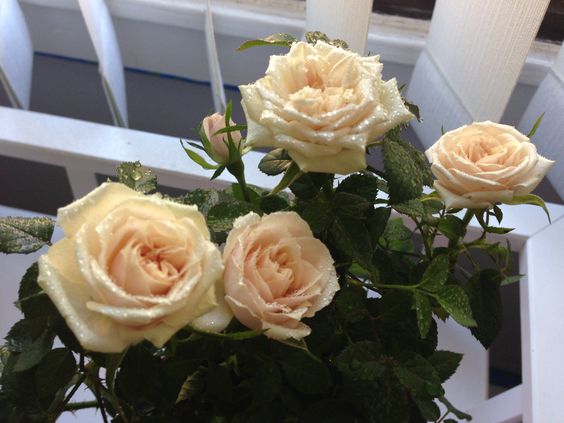

Favorable time for transplant
The best time of the year to transplant roses is early spring or early autumn. In spring, the weather should be warm, free from frost, but it is advisable not to postpone the matter until the summer heat. In the fall, all work must be completed by the end of September, otherwise the rose will not have time to take root in a new place and get stronger before winter.
Summer is not the best time to transplant adult roses, but if you create optimal conditions for the plant, the chances of success are high. You should not plant old bushes in an open sunny place, in the evenings, after sunset, it is good to spray the crown of the bush - this will help him to transfer the heat. 2-3 weeks before transplanting, you need to cut the shoots to 40-50 cm, be sure to remove the flowers and buds so that they do not take away the vitality of the bush.


Features of transplanting climbing varieties
Before digging up the roots, you need to disconnect the shoots from the support. If a rambler is to be transplanted, young shoots do not need to be cut off, and branches older than 2 years old must be completely removed. At the end of the season in August-September, the tops are pinched on the shoots of the current year.
For claimings, the situation is slightly different: before transplanting, the length of the shoots should be shortened by half.
Roses are the decoration of the garden. Therefore, many grow the "queen of flowers" in their personal plots. Sometimes, for various reasons, it becomes necessary to transplant a plant. If you do it wrong, you can destroy the bush.
Choosing a place for a rose garden
To grow roses, it is extremely important to find the right place so that no transplanting is required due to poor conditions. Of course, you can experiment, but it is better to think over the place for the future flower bed once and enjoy the result.
The prerequisites that will ensure normal growth and full development of a flower bed with roses include:
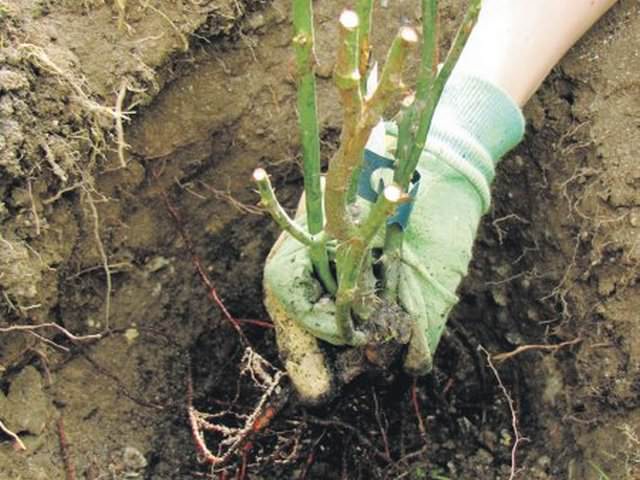

- Illumination. Roses need a lot of light for vigorous growth and spectacular flowering, so you should examine your garden plot in order to identify the area where the sun's rays fall most of the day. The shade from buildings and trees, which will shelter the bushes from the sun, will adversely affect the flowering process, so the place for the rose garden should be in a lighted area.
- Windproof. Strong or constant winds can disrupt the harmony of flower beds, so it is worth considering the location in such a way that the plants are protected from aggressive weathering. Trees, ornamental shrubs and garden fences will help to cope with the task perfectly.This arrangement of flowers will provide active summer bloom and shelter from winter blizzards.
- Moisture. Location at the foot of the slopes or in the lowlands will contribute to the accumulation of excess water in the soil, which negatively affects the root system of roses and causes rotting, and in autumn and winter - freezing.


- Soil composition. The presence of clay and mineral-rich soil is a plus for growing roses. But if the site does not meet the soil requirements, then it is possible to get specialized soil for the flower bed and replenish it in a timely manner.
It is best to choose a place for a future flower bed in the fall. So you can evaluate all the advantages and disadvantages of the site and find the best place for roses.
Air humidity
Miniature roses need high humidity. If the indoor rose is in the fresh air in summer (on the balcony or in the garden), then additional air humidification is not required. In winter, it should be placed with a pot in a container with wet pebbles.
Also, do not forget about moisturizing the rose with a spray bottle. In dry and warm air, spraying is recommended twice a week, even in winter. If in winter time in the room where the plant is located, the air temperature is low, then it is better not to spray the rose.
In hot summer weather, spraying is not recommended.
Advice! If the air is too dry, the rose needs to be humidified, otherwise it can get sick.
Common varieties
The following plant varieties are most often grown at home:
- Bengal red rose. This is the most common variety of roses. It is unpretentious, does not shed leaves after flowering. Flowers are odorless. They do not need pruning, except for dried or diseased branches.
- Miniatures. Bushes no more than 30 cm, flowers are collected in inflorescences and have a delicate aroma. They come in white to black. The variety has abundant flowering and does not require pruning.
- Baby Carnival. This plant has abundant flowering. It is chosen for rooms and decoration of garden borders. This yellow rose is loved by flower growers.
- Pixie. The plant has two-colored double flowers - white with a pink central part. The plant blooms profusely and for a long time, it is 20 cm high.
- Eleanor. It grows most in the south. The bushes are 30 cm high and have coral flowers.
Whichever variety is chosen, it is necessary to transplant it correctly. Then the plant will delight with beautiful flowering.


